Ireland Trip 2023
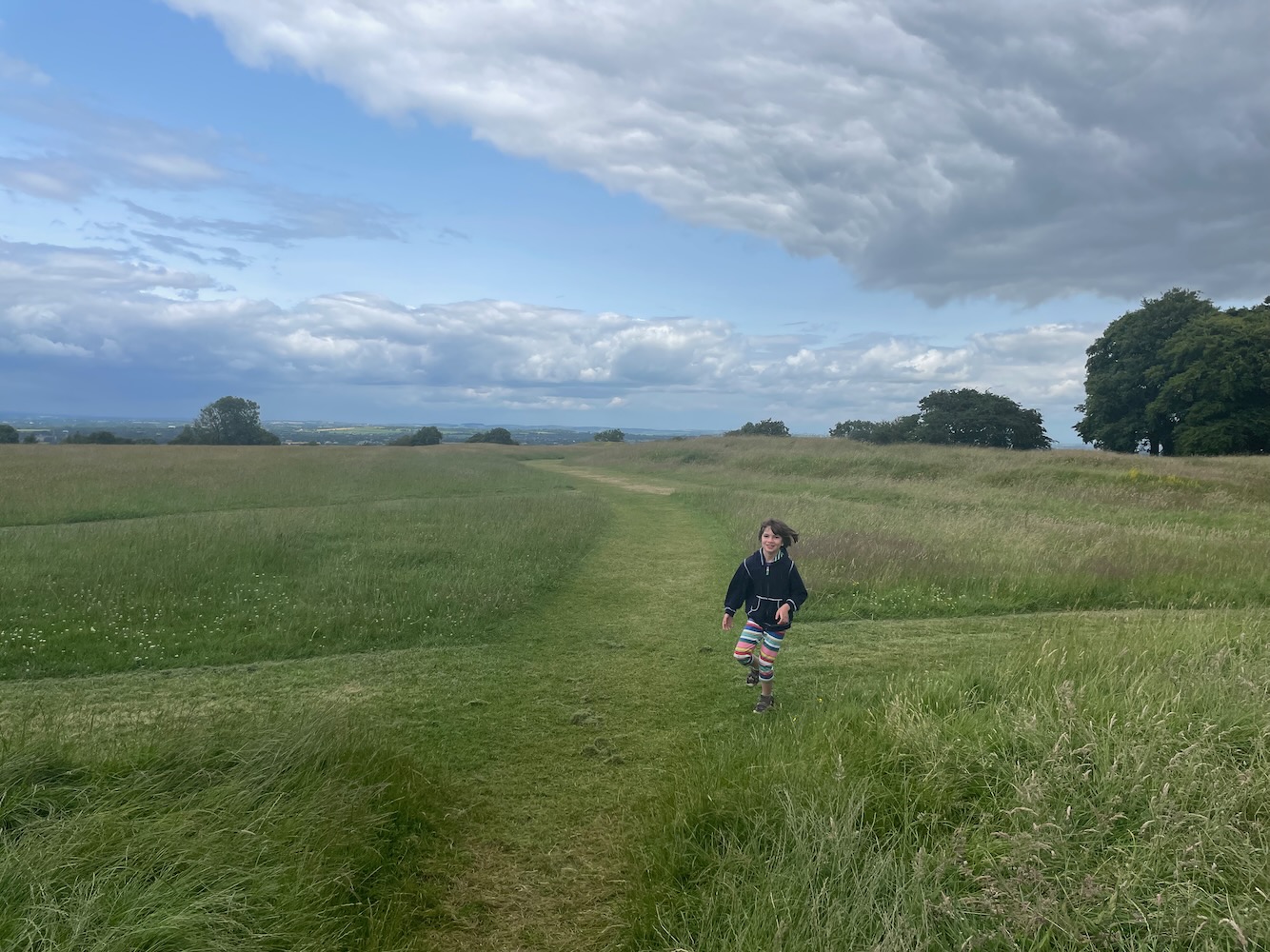
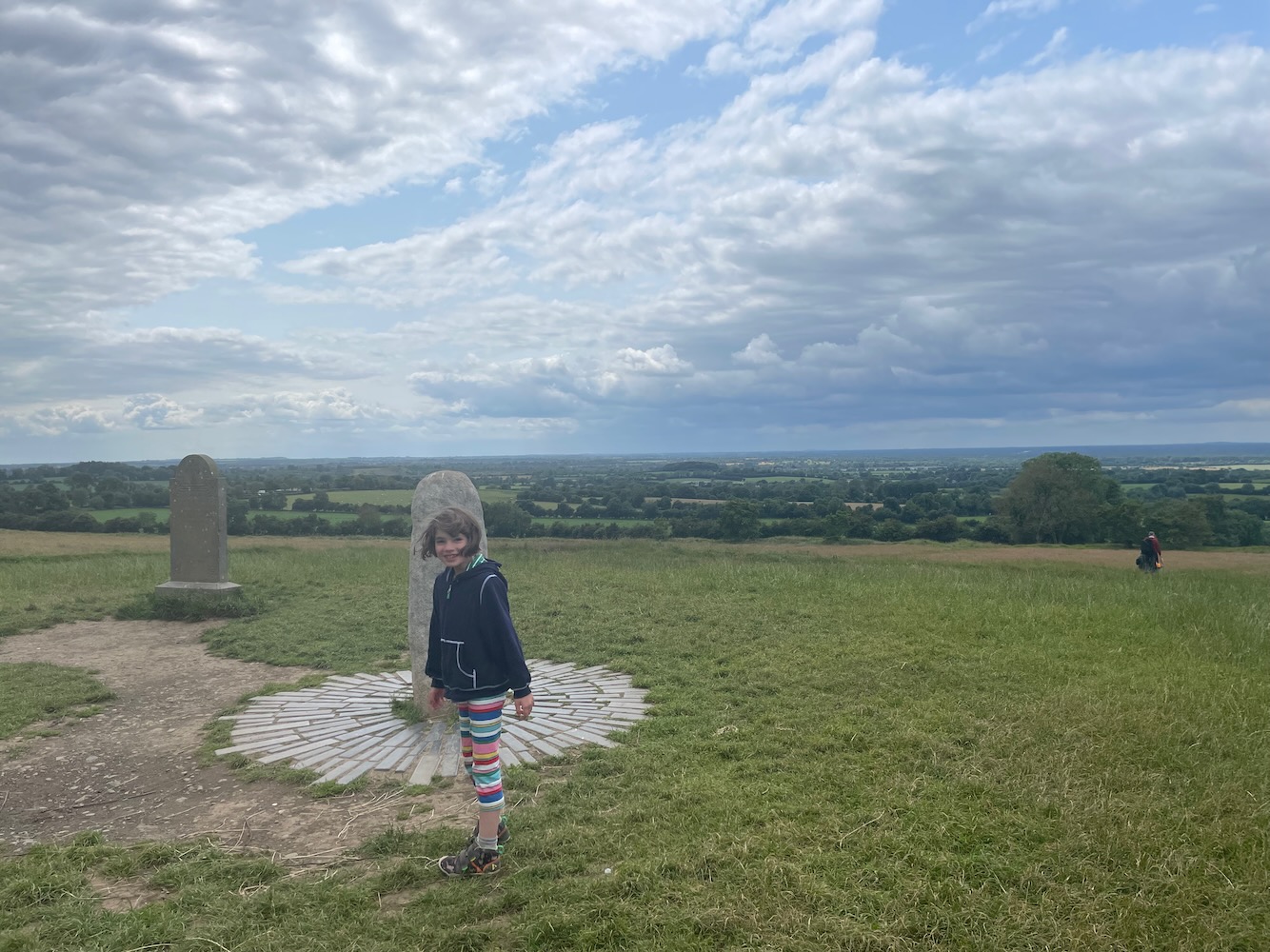
From lunch after the chocolate factory we drove a short distance to the Hill of Tara, the site of so many high kings of Ireland, and walked and ran all over the site. Everyone could touch the old standing stone, which supposedly would roar when one of the future kings or queens of Ireland touched it. Marcus cued up a roar on his phone and played it when Robert touched it, and Helen (who did not see his sleight of hand) just kept going on and on about how it didn’t roar for her or Marcus or me, but it DID roar for Daddy (Samantha declined to do this).
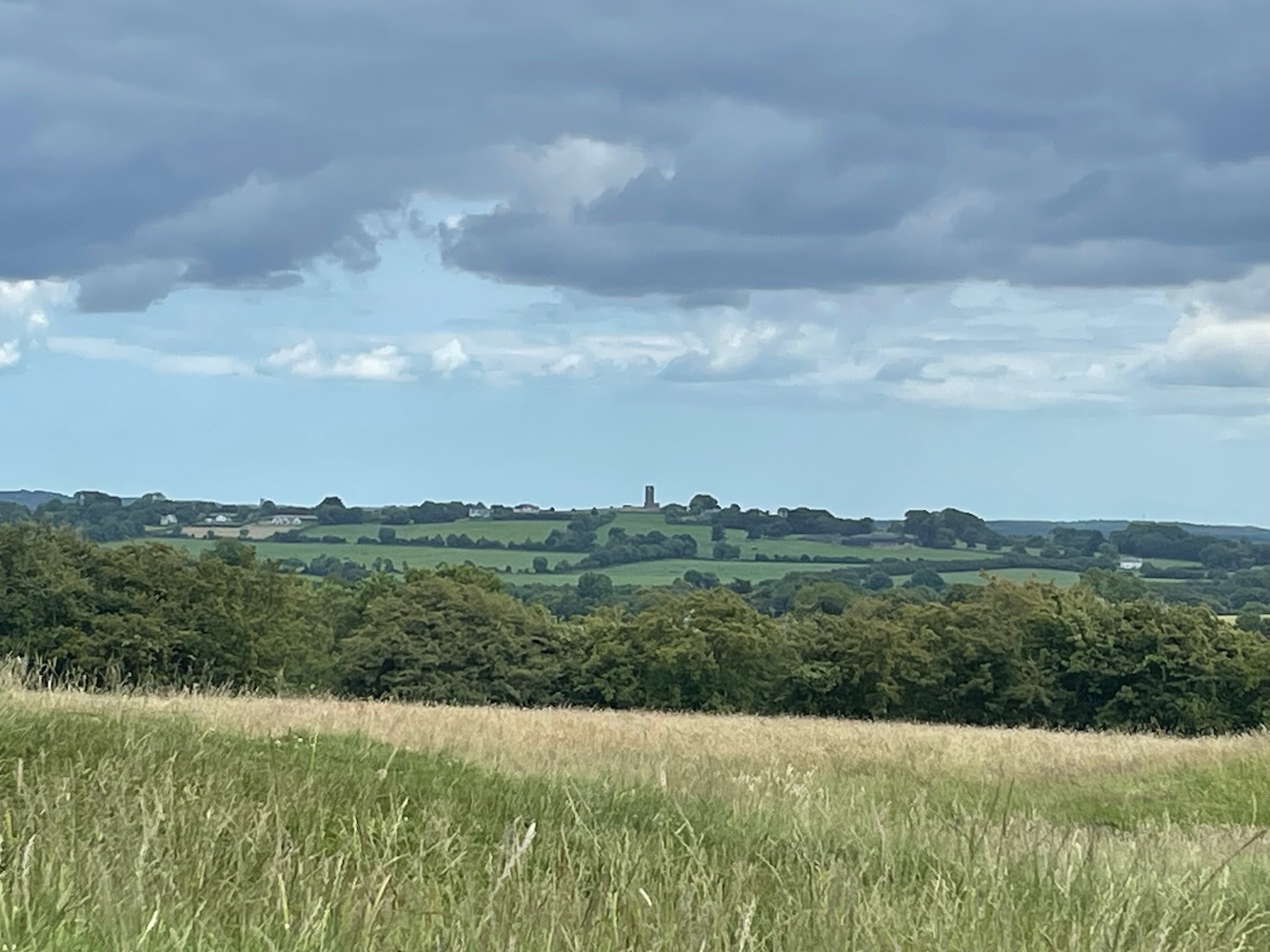
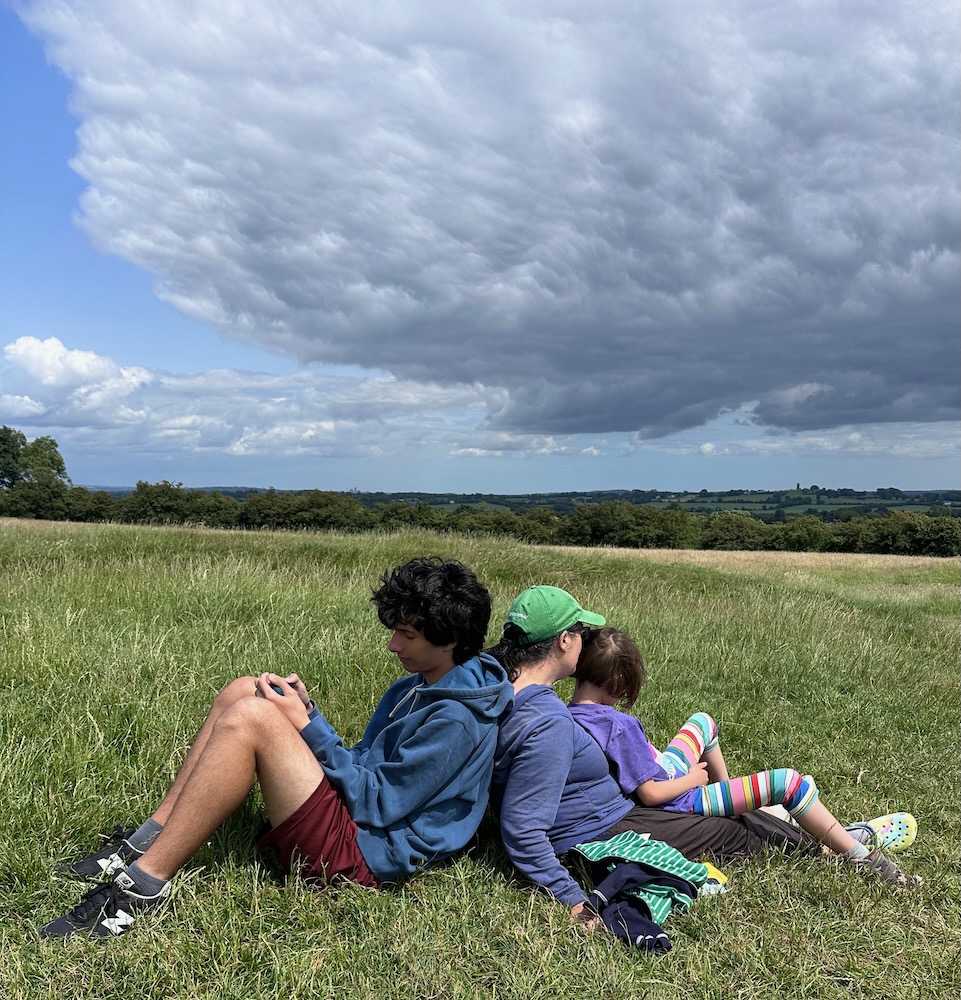
You could see really far from there—it was impressive. I should also mention that it rained very briefly while we were there, maybe about 5 minutes, and then stopped. Even through our last day, we had a completely unbroken streak of being rained on every day, though usually for less than 15 minutes. Impressive, though!
From Tara we drove to the Bru na Boinne visitors center, which is how you can visit (by pre-booked tour only) the passage tombs at Knowth and Newgrange. This was something I’d been really looking forward to—medieval castles are nice, ruined abbeys are nice, but 6000 year old tombs and sacred spaces? Just, wow.
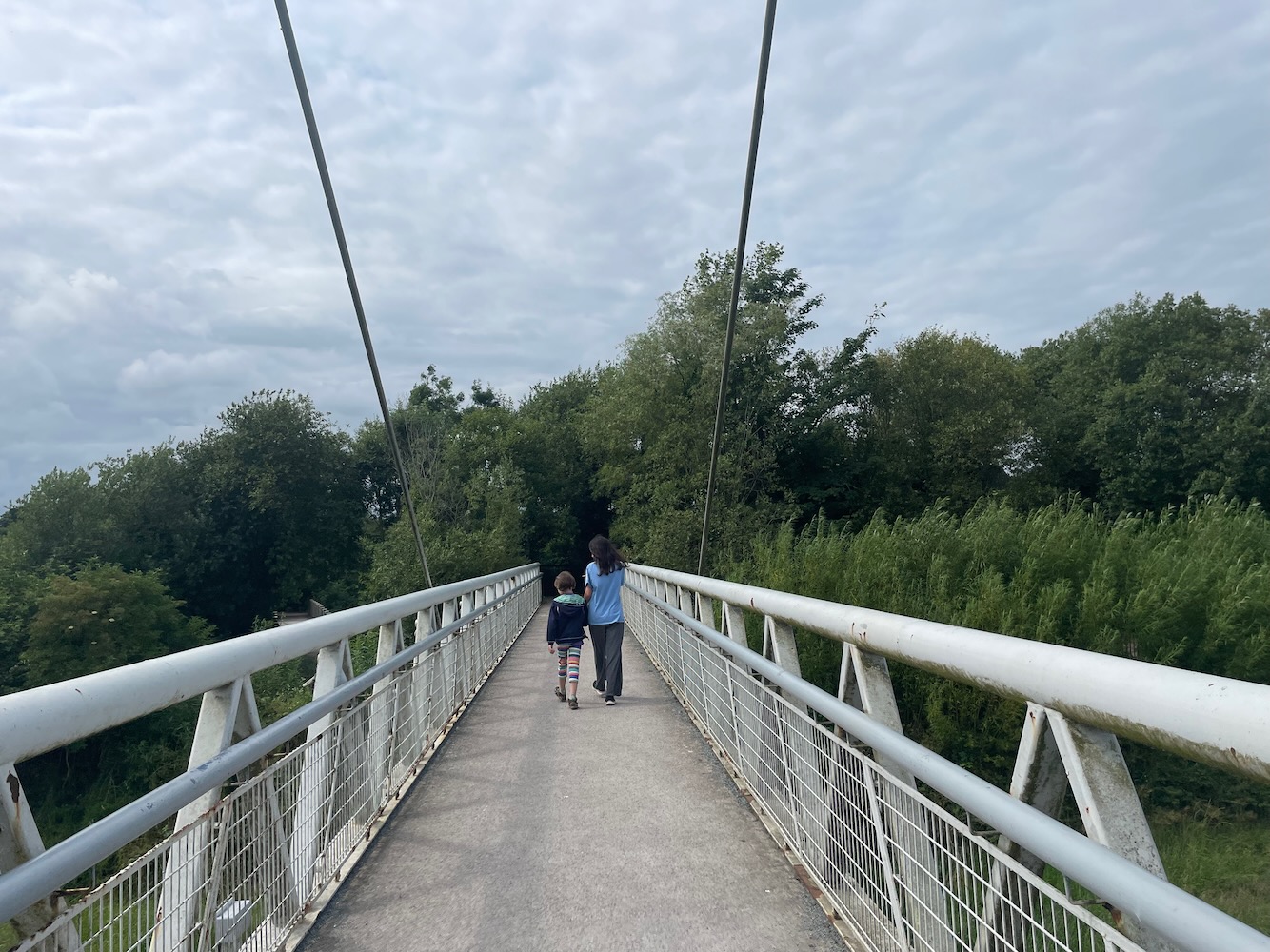
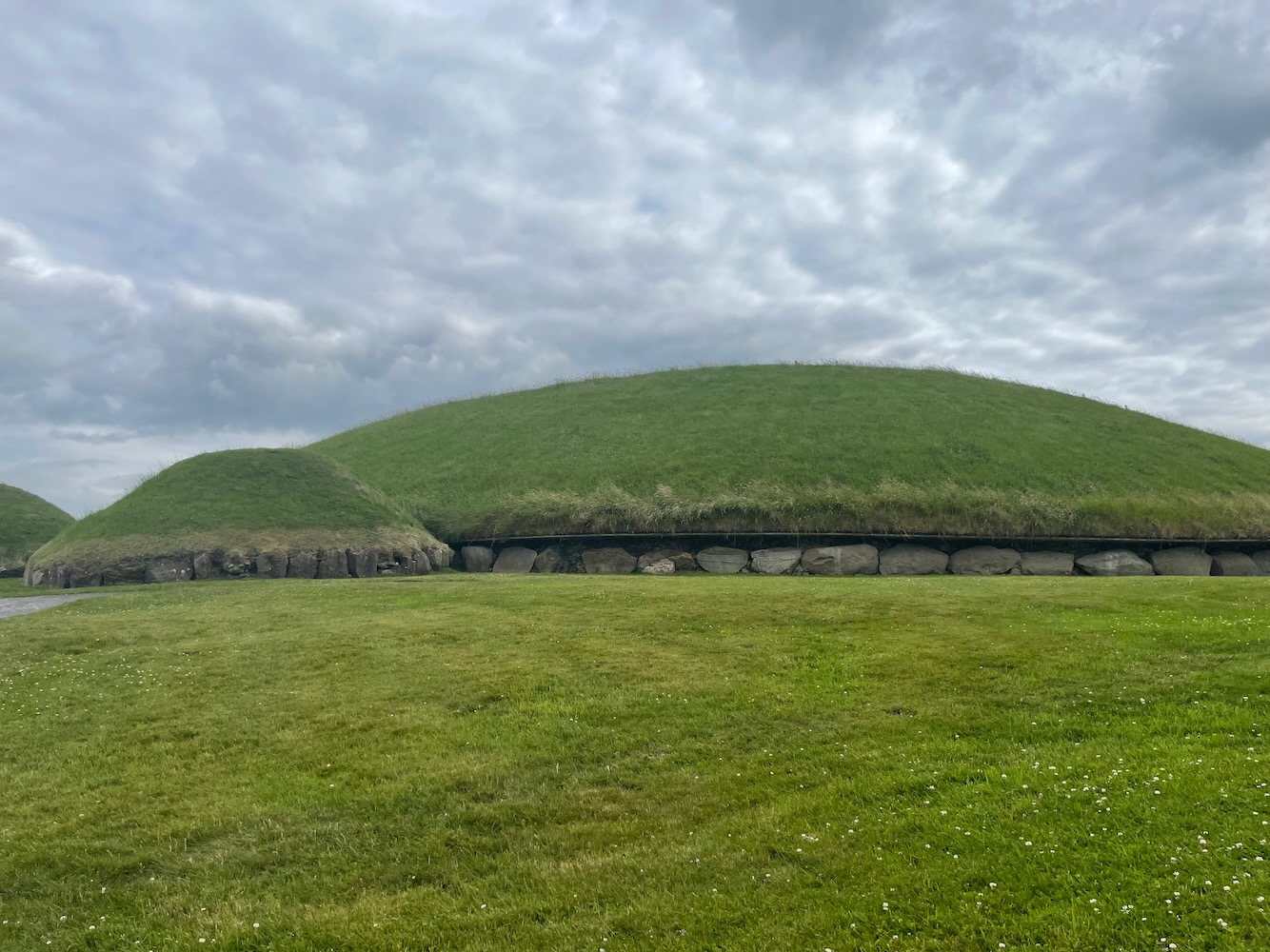

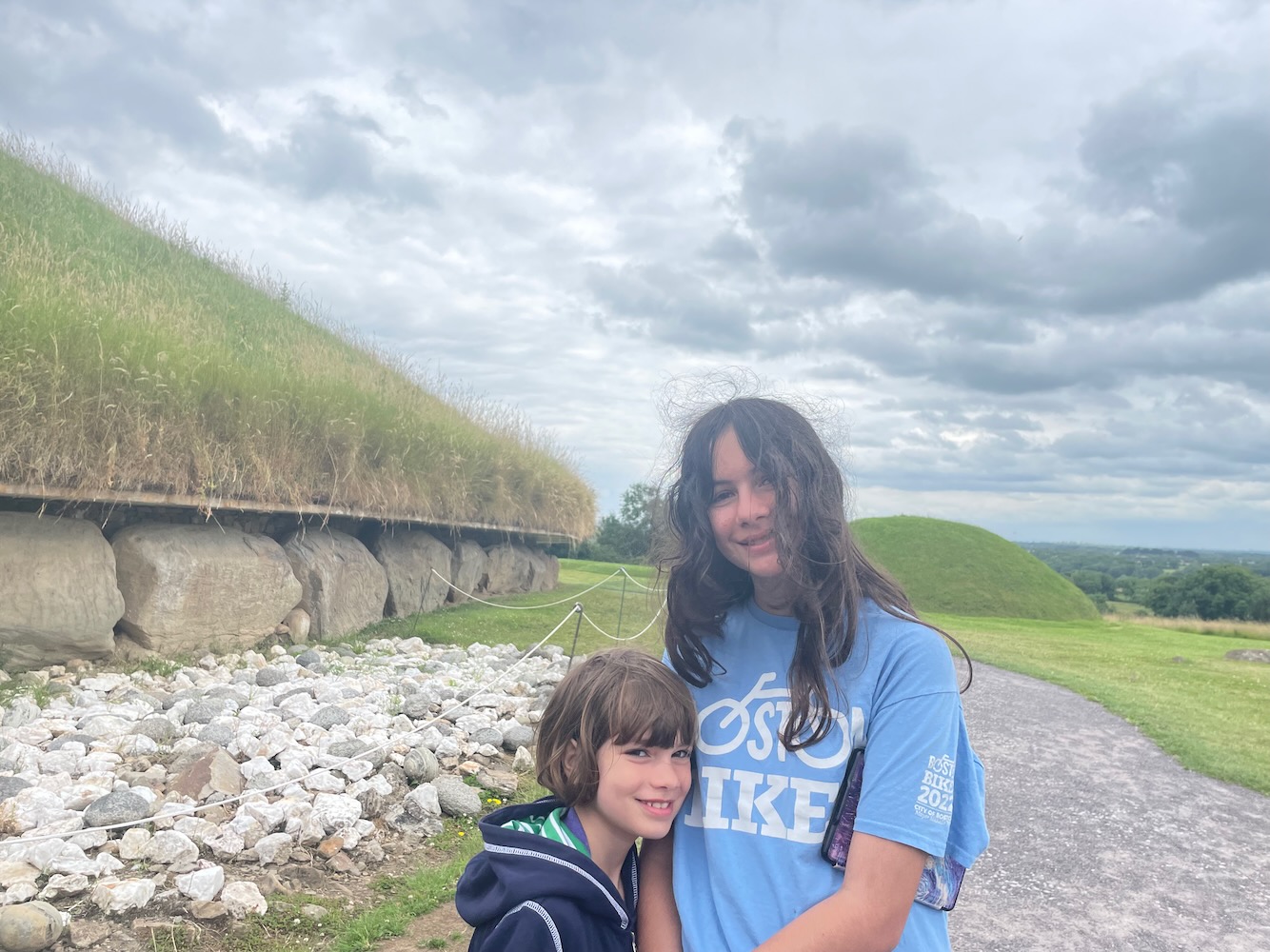
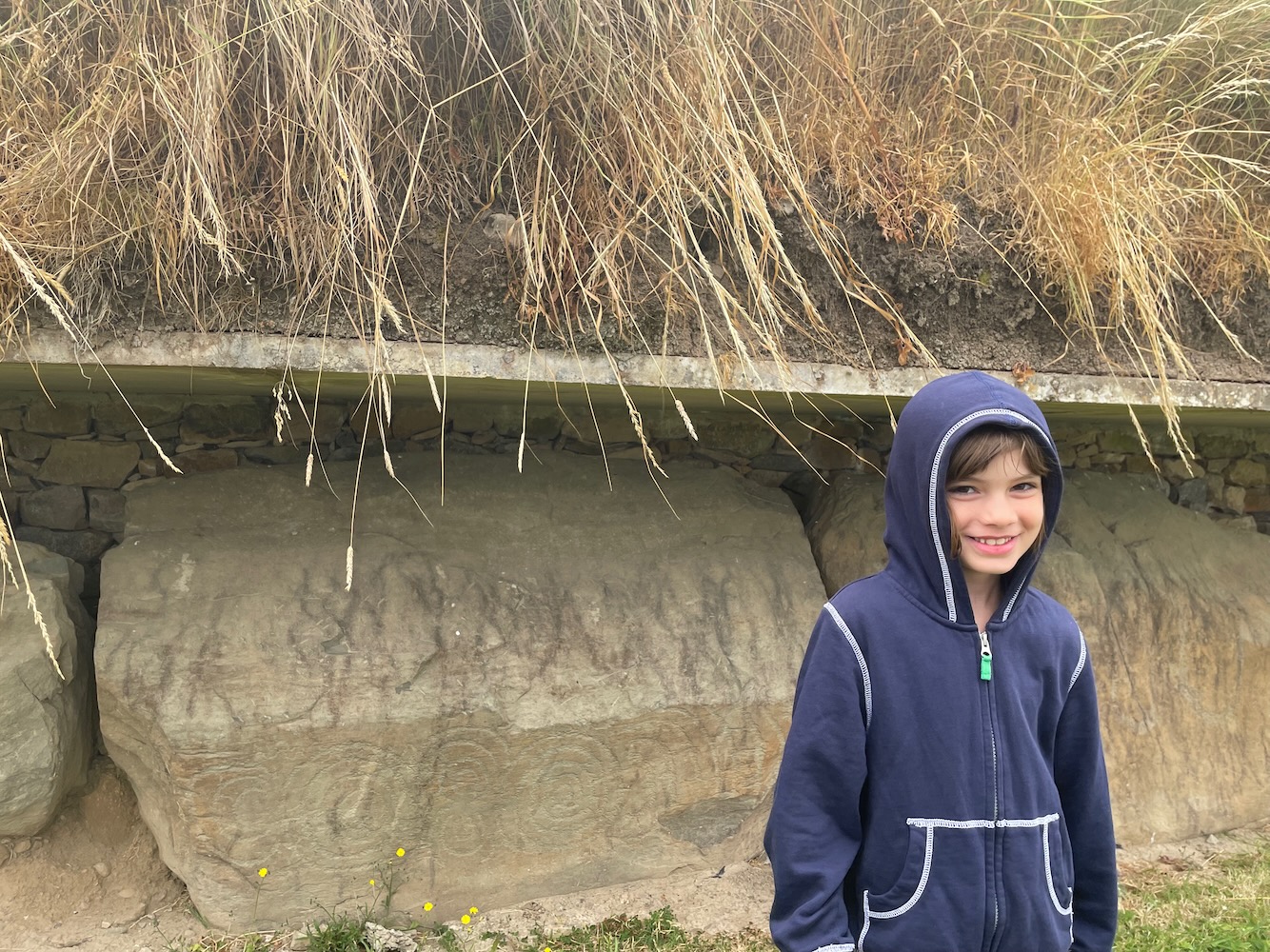
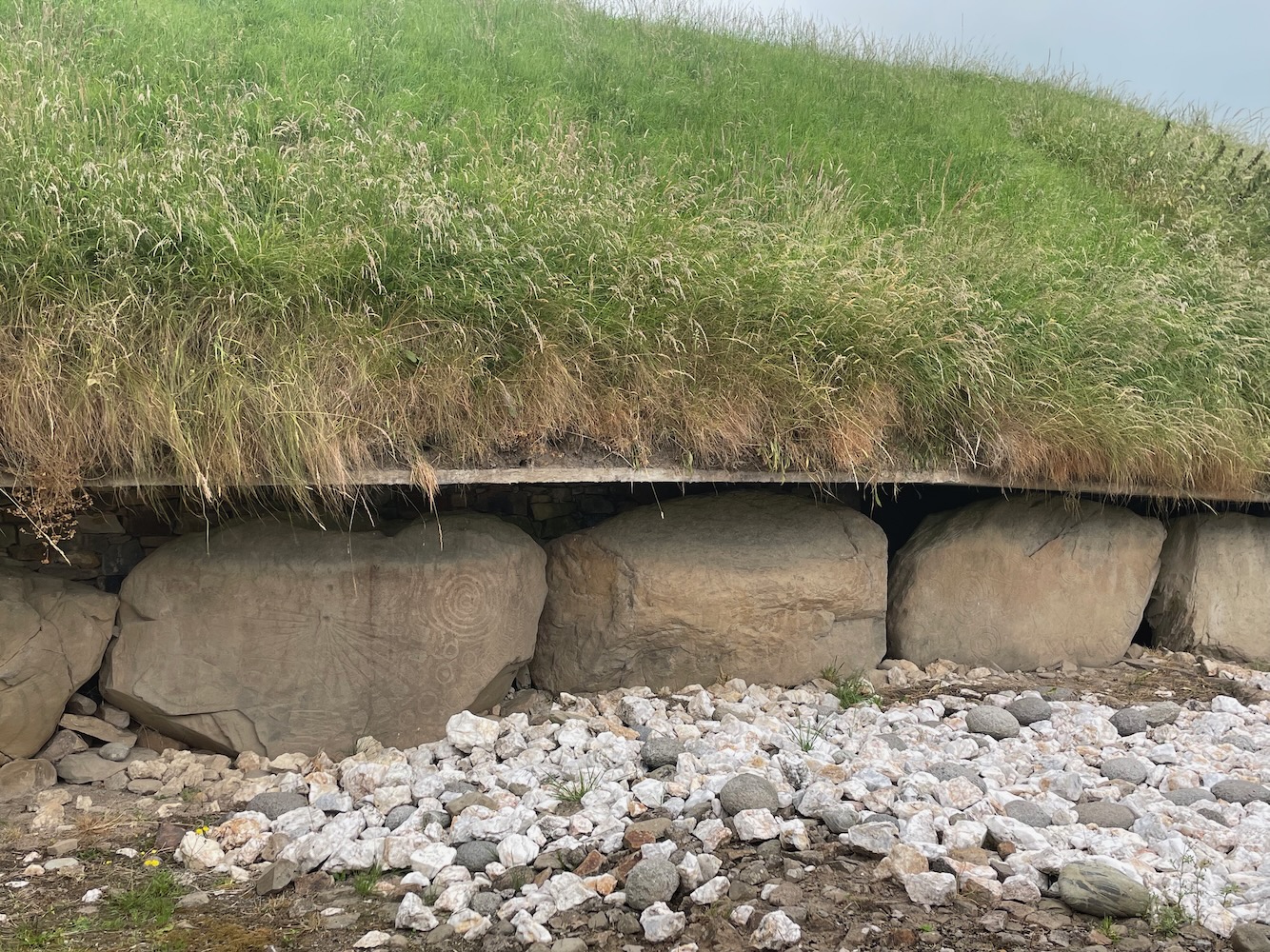
The visitors’ center there was wonderful, with a really great interactive exhibit about the Neolithic people (including a fun game where you had to harvest enough berries, wheat, fish, and deer to get your family band through the winter), and a long bit about the archaeologist who was responsible for excavating Newgrange in particular.
Then you walk down a bridge over the river Boyne and take a shuttle to the first tomb, where you can walk around it and onto the top of it, but not into it. Then you can walk down a hill to another visitors center that has great images of the different stones, and an interactive exhibit and space for you to do rubbings of recreations of the stones. From there the shuttle picks you up again and takes you to Newgrange, where you can go into the tomb, and they turn out the lights and show you with an artificial light shining into the roof box what it looks like on the winter solstice when the sun rises and shines all the way into the central chamber of the tomb. It was all very, very cool—so much so that Marcus and Samantha also really enjoyed it (Helen of course enjoys everything).
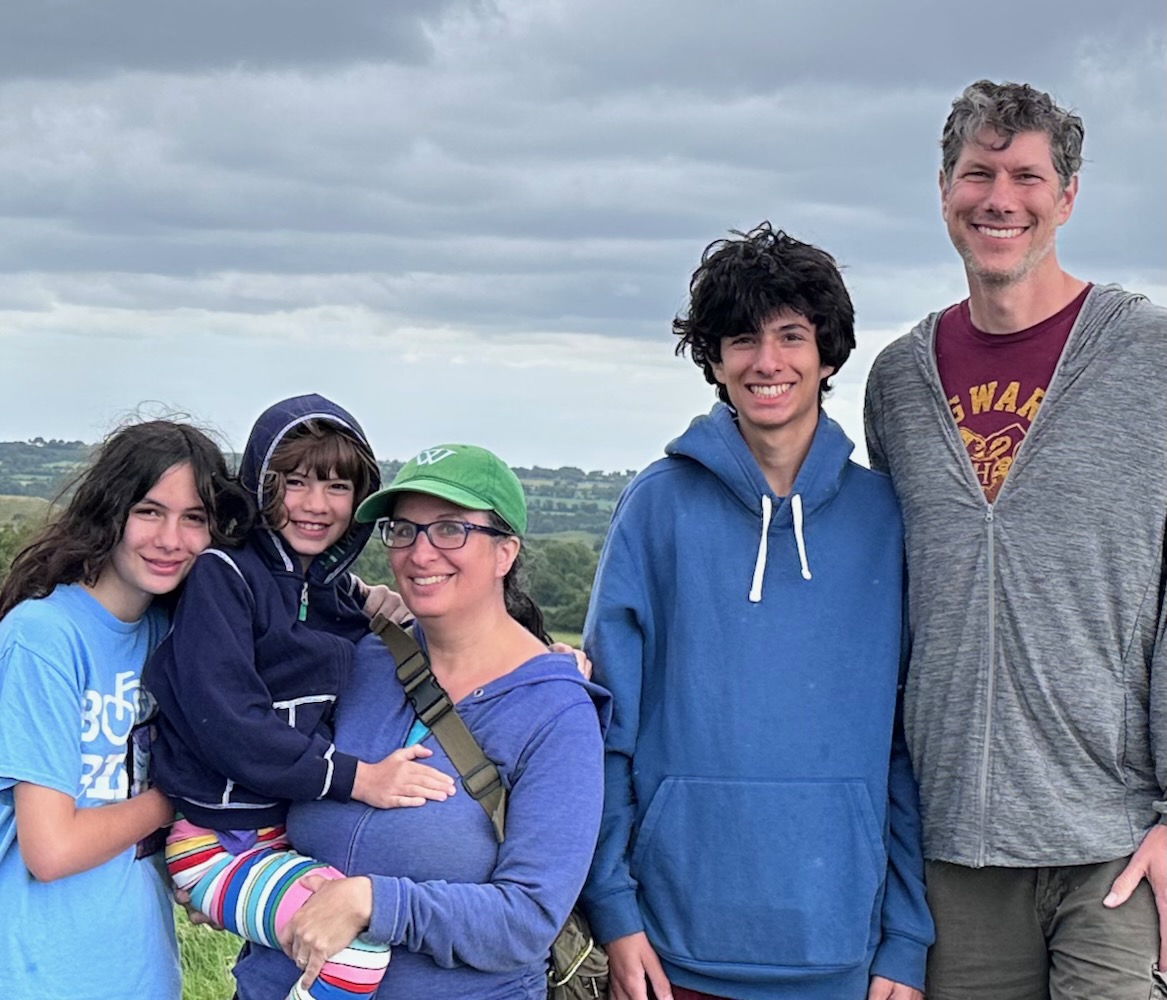
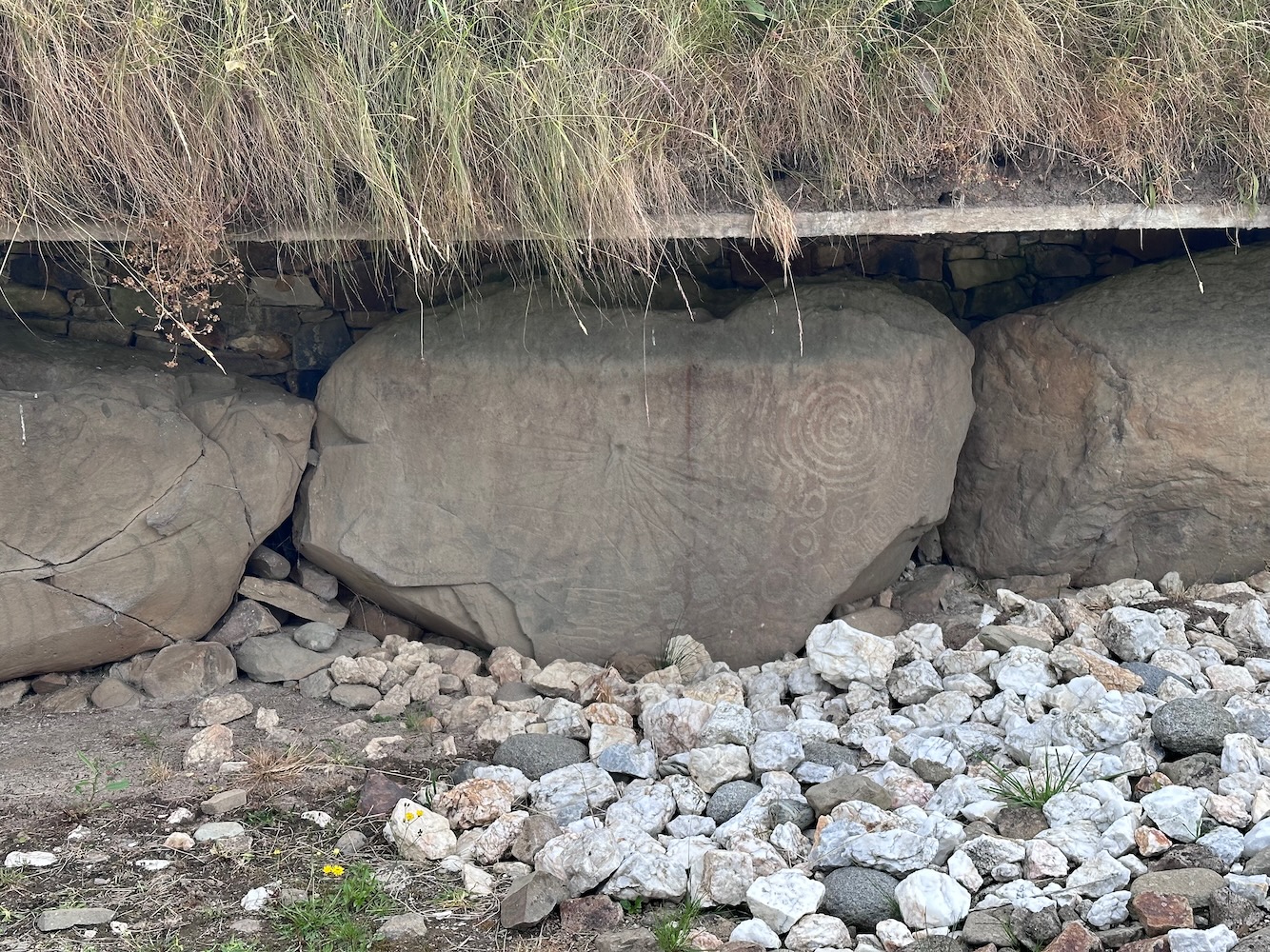
It’s really excellent the way they limit the number of people to the site and really care about preserving it, not letting too many people in. Our tickets were for 3:00, and we didn’t leave until 6:00. It was never rushed—you had plenty of time at each site to sit in the grass and look and reflect. It also rained on us for 5 minutes or so again at Knowth, actually.
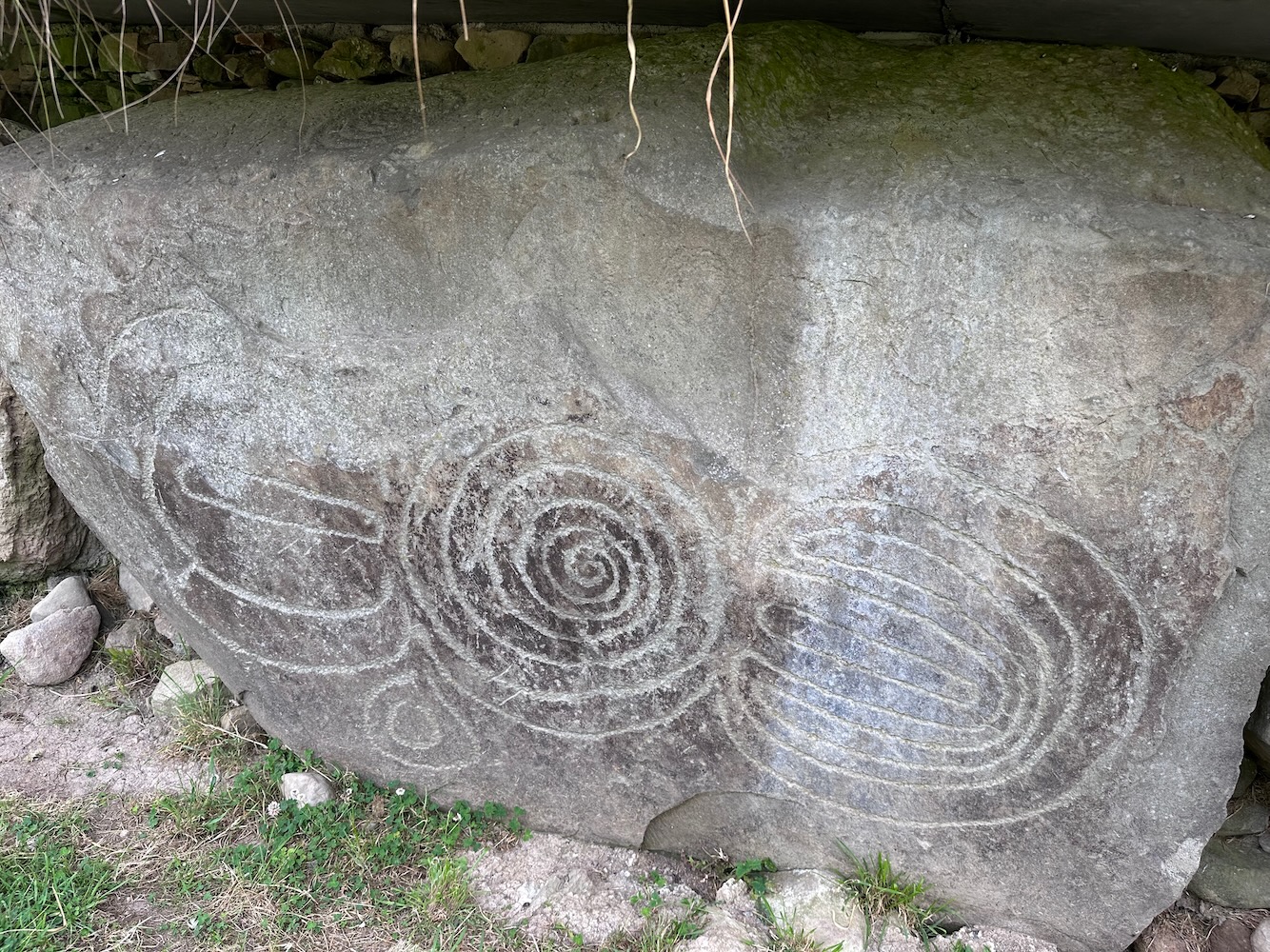
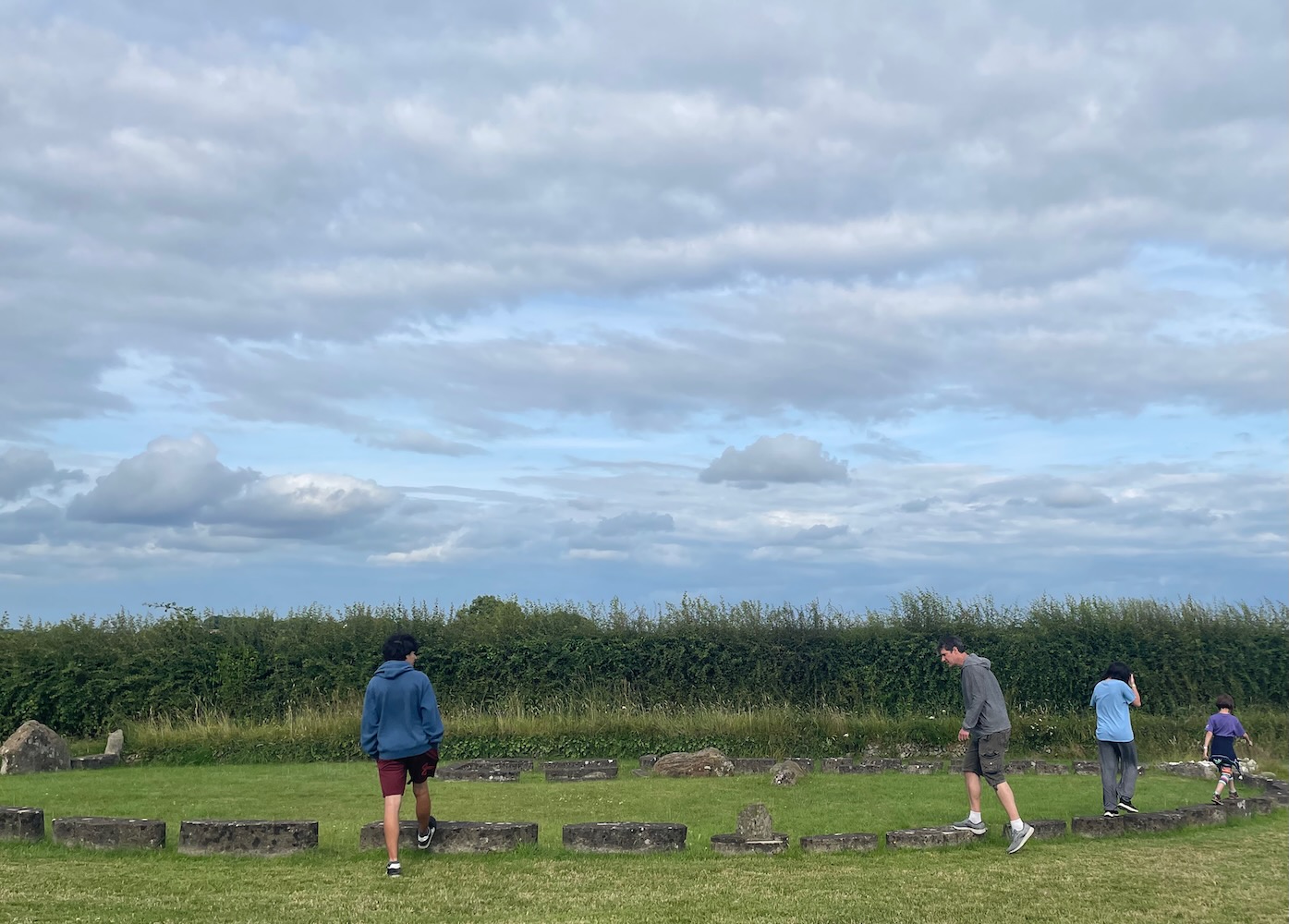
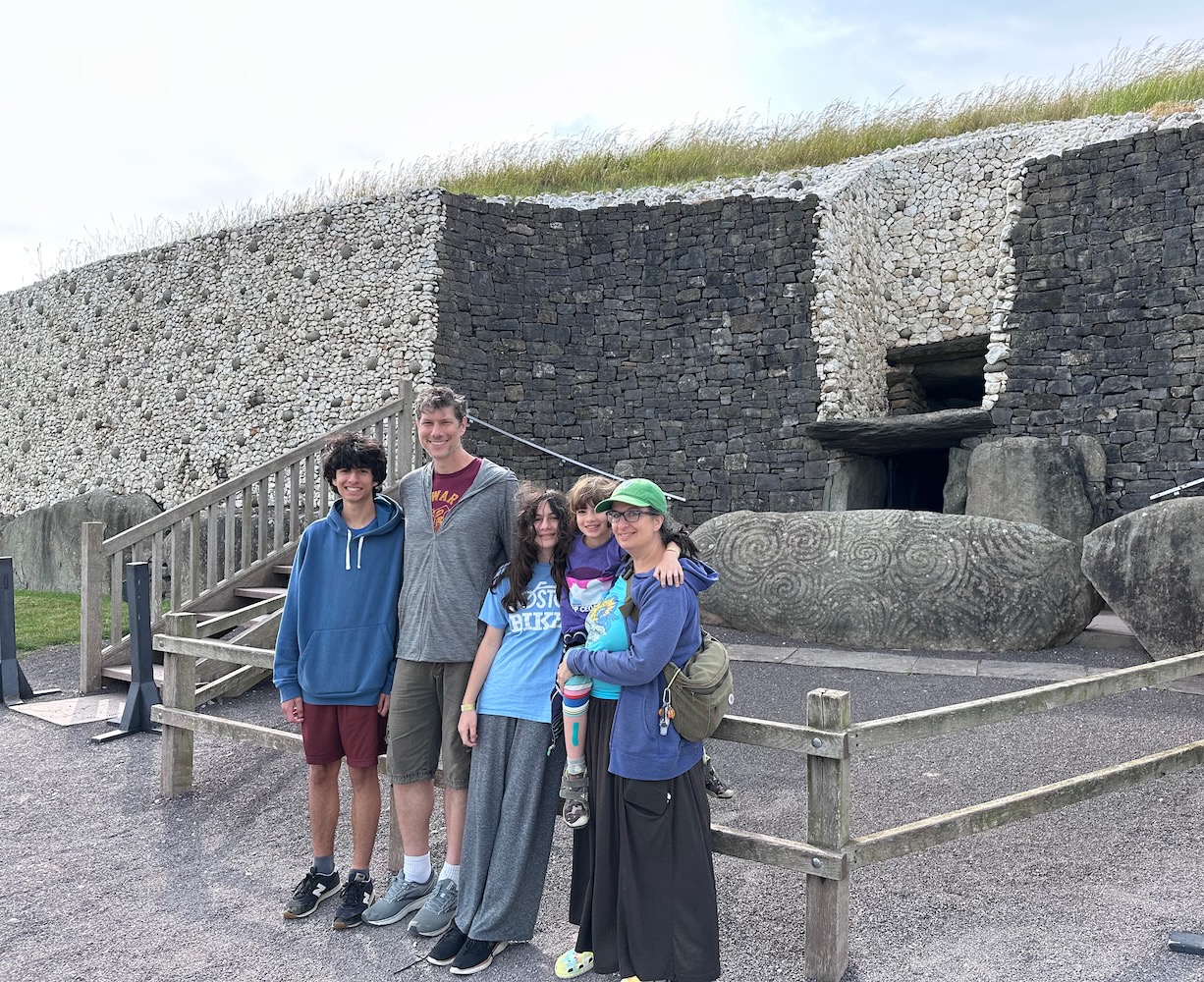
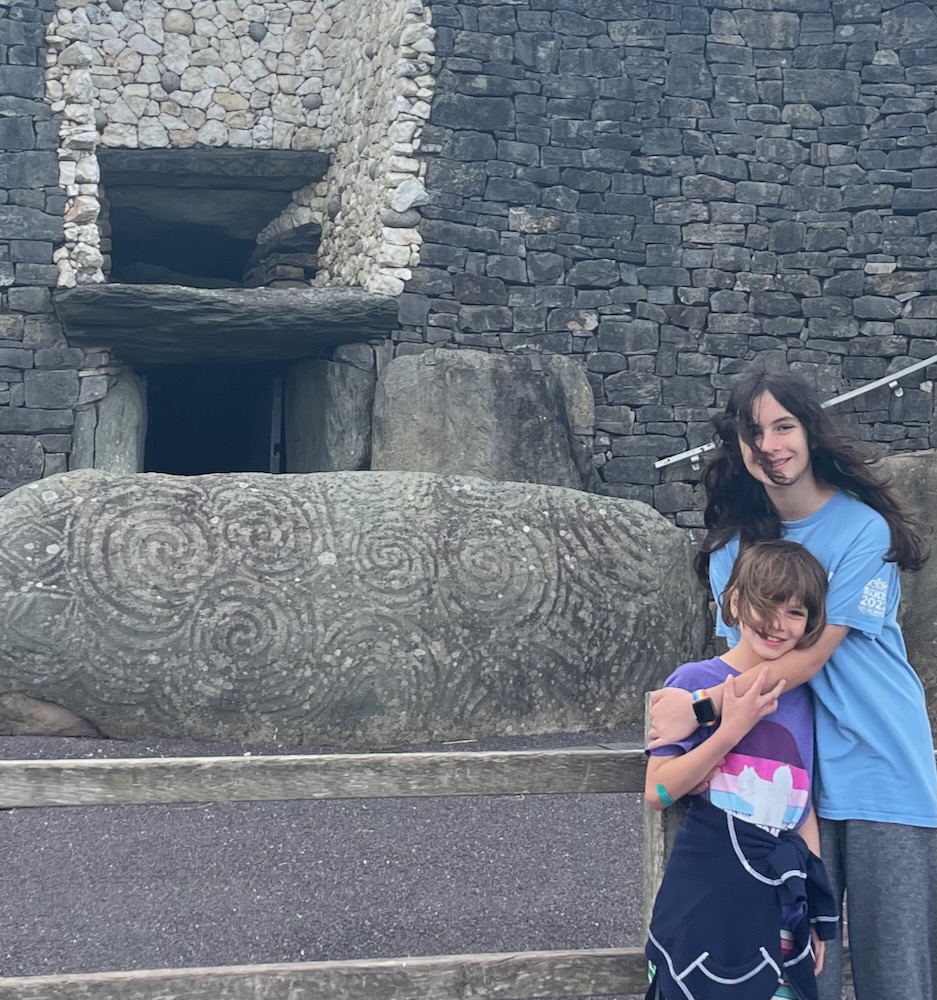
From there we went to dinner at Man o War in Balbriggan, where we had local steamed mussels, that potato leek soup, a seafood pie, shrimp two ways (one with chili butter and one in a potato gratin) another burger (Marcus again attempted to order it rare, this time to be told no, it was unsafe, and country-wide regulations say they cannot serve it rare), and a “bacon fillet” for Samantha (I would have called it a pork chop on the bone, but it was excellent marketing—she loved it, and it was pink and juicy)
Our final B&B was Hillview House in Lusk, where we had a family room that had two double beds and two single beds. It was very comfortable, even though we were going to be leaving too early both mornings to take advantage of the breakfast (the nice woman cancelled our reservation and rebooked us at a cheaper rate to make up for that).
On Friday morning we had to be in the Malahide marina near White’s Laundry at 7:50 to board a boat with Eamon (“Fish and Trips”) to Lambay island. Actually the “ay” means island, so the name means lamb island and it’s often just called Lambay.
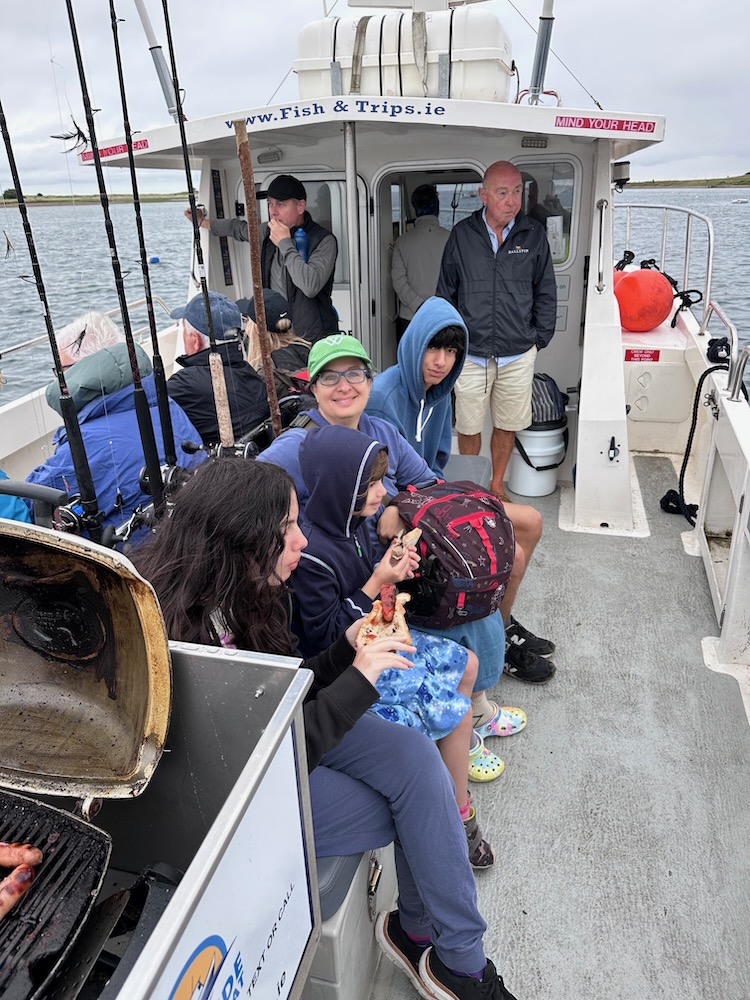
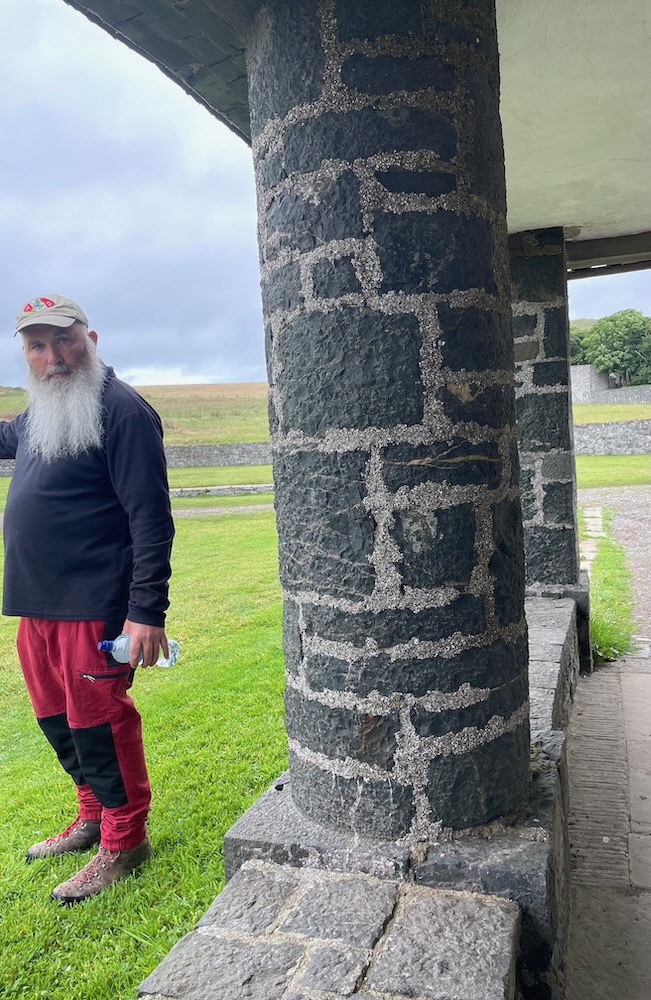
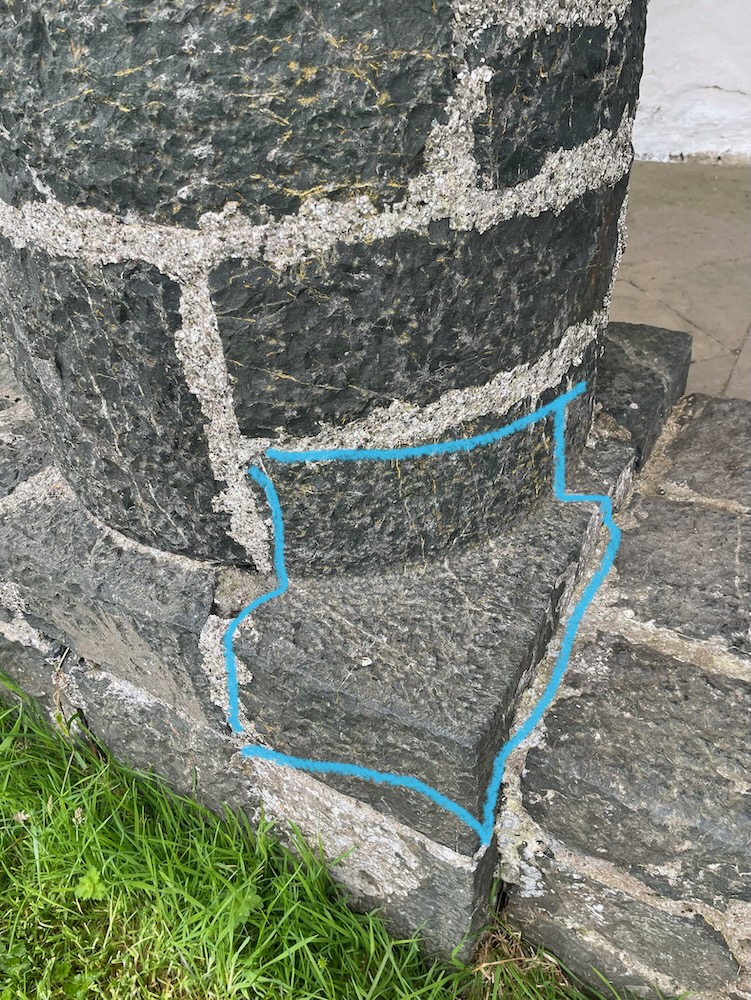
It’s the largest island off the eastern coast of Ireland, and it has the easternmost western-facing beach in Ireland. It’s privately owned, and the family who developed it in the early 1900s (a British man who married an American divorcee and was therefore basically shunned by British and American society) employed the famous architect Lutyens, who did a bunch of monuments in London and also almost all of modern British Delhi, to build them a house and also to renovate the existing dwellings on the island for their staff.
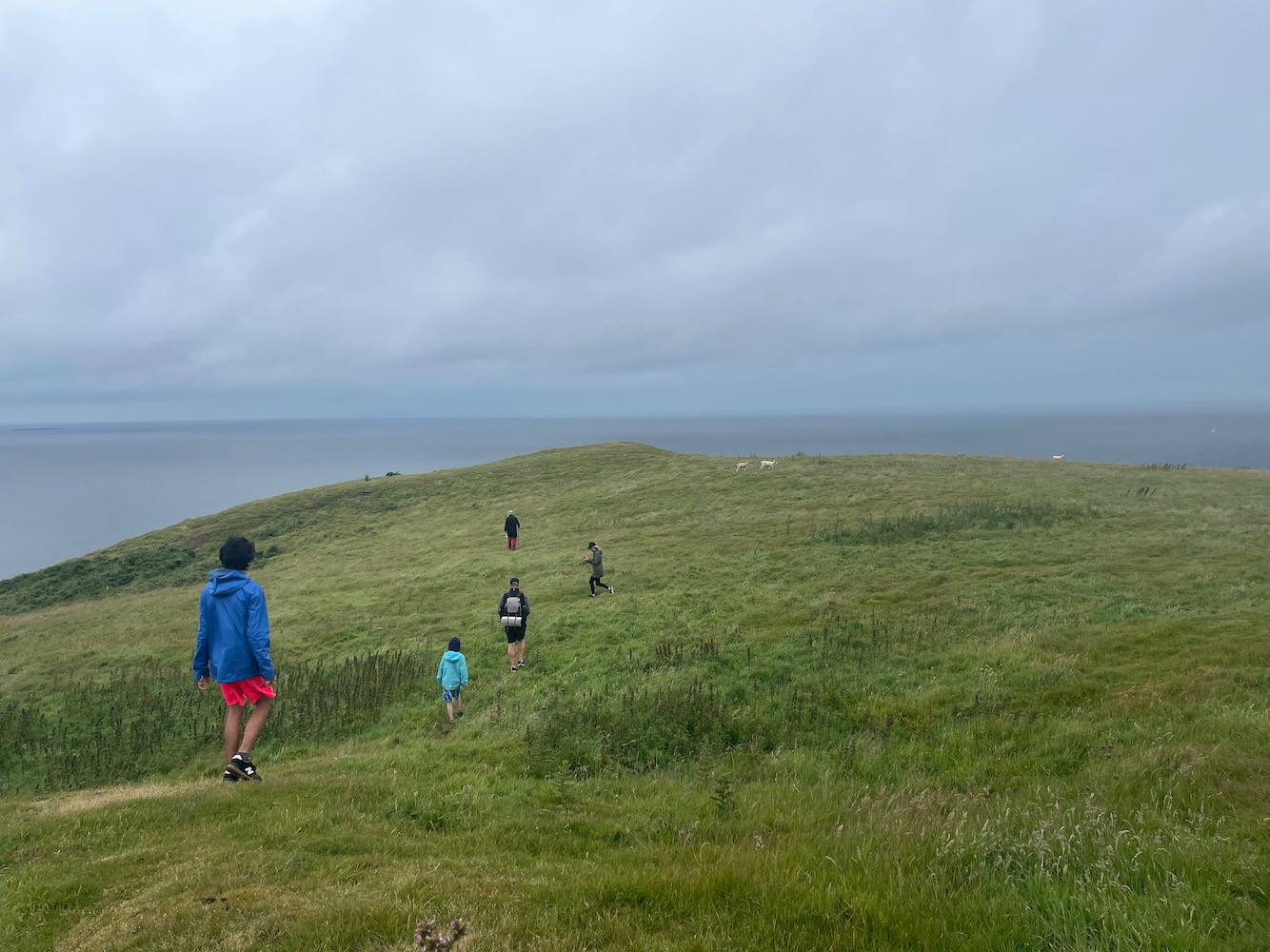
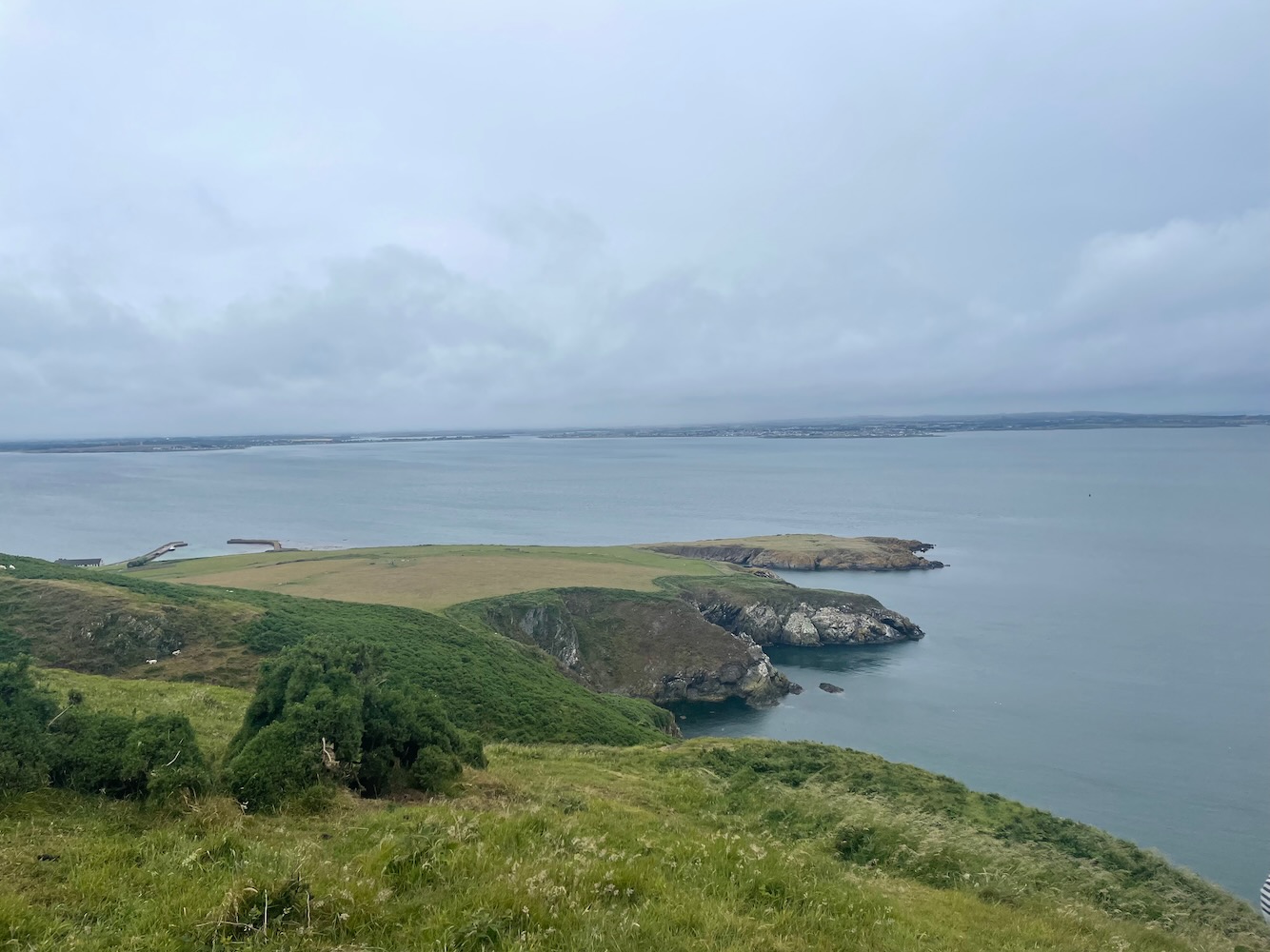
As a result there were really cool architectural details, like alternating round and square columns made from the native island stone (the island itself is a long extinct volcano and the stone is beautiful and dark), plus cornerstones on the columns that go from square cut on the bottom to rounded at the top (Eamon said Lutyens was a "show-off"), in the same stone, and roofs that angle in 2 1/2 tiles from bottom to top because he wanted to echo the curve of the harbor in the roof.


Our boat had us, Eamon, and then 8 local folks from Malahide: a priest (who everyone called “Father” and referred to as “the priest”) who maintained the island chapel and performs funerals and weddings (but weddings only for the family who owns the island, because otherwise, as a chapel on a private island 30 minutes from the mainland, it would violate the rule that weddings be performed openly, allowing anyone to “speak their piece” during the ceremony); an older woman who is a professor of educational legal access and also owns a boat but has never been to the island before because it’s not open for private docking; and three couples (two in their 60s, one in their 40s) who had never been to the island but were always curious to go. They all agreed that “Americans never go to Lambay,” and laughed at our description of the rest of our trip (“you mean, you went to all the places Americans normally go,” they said) but said we did make a good choice by coming here today.

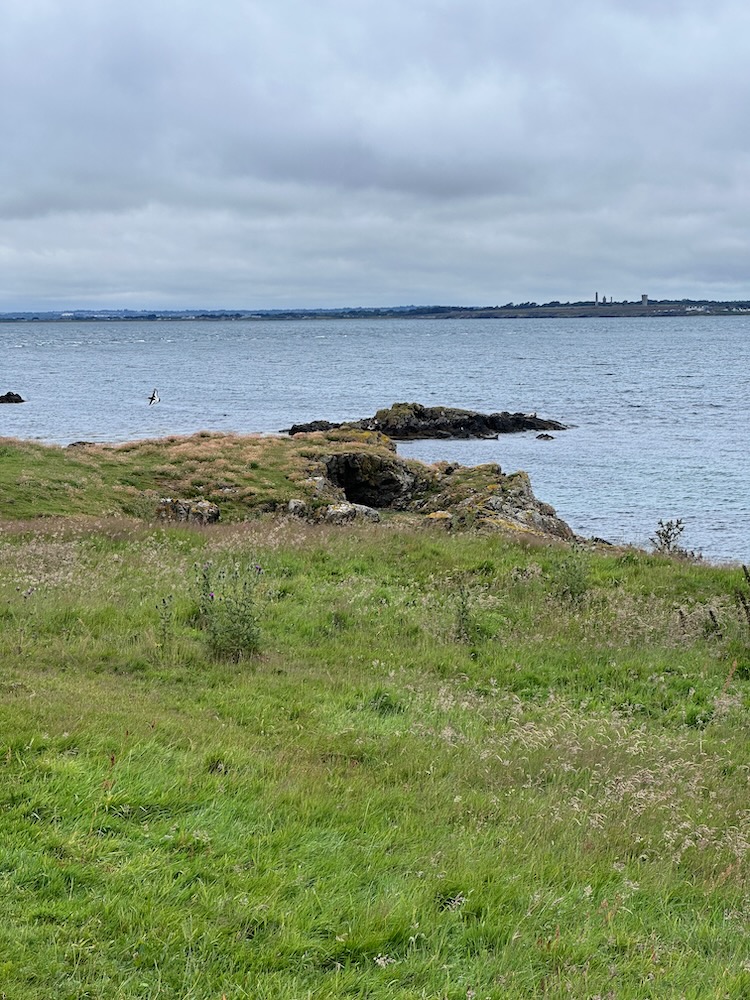
We spent about four hours on the island, first walking around the base of the island and talking about the buildings, seeing the chapel (and leaving the priest there, with him promising to meet us at the harbor at the end), and using the bathroom in a little building (Eamon: “this is the ladies—the gents is everywhere”). Then we walked out to see seals and seabirds on the rocks off the coast of the island, and then we walked up to the highest peak on the island, to an ancient cairn there that was one of the burial sites for the kings of the tribe of people who lived on the mainland.
Along the way we saw lots of sheep (more with the red and blue or green markings, which Helen called “rainbow sheep) and also wallabies—imported to the island in the 50s or 60s, and thriving here. They actually now are culled for population control purposes and sold for 750-1000 euros for petting zoos and such, “in Texas and Shanghai, you know,” Eamon said). We saw the trap they use for the wallabies, a little wood tunnel that is normal and the wallabies run through happily every day, but then every six weeks or so they pull a pin at dusk, and when the (nocturnal) wallabies run over it, one of the floor sections falls out so they drop into a small space below the run. In the morning they come by with a little off-road golf cart and round them up.
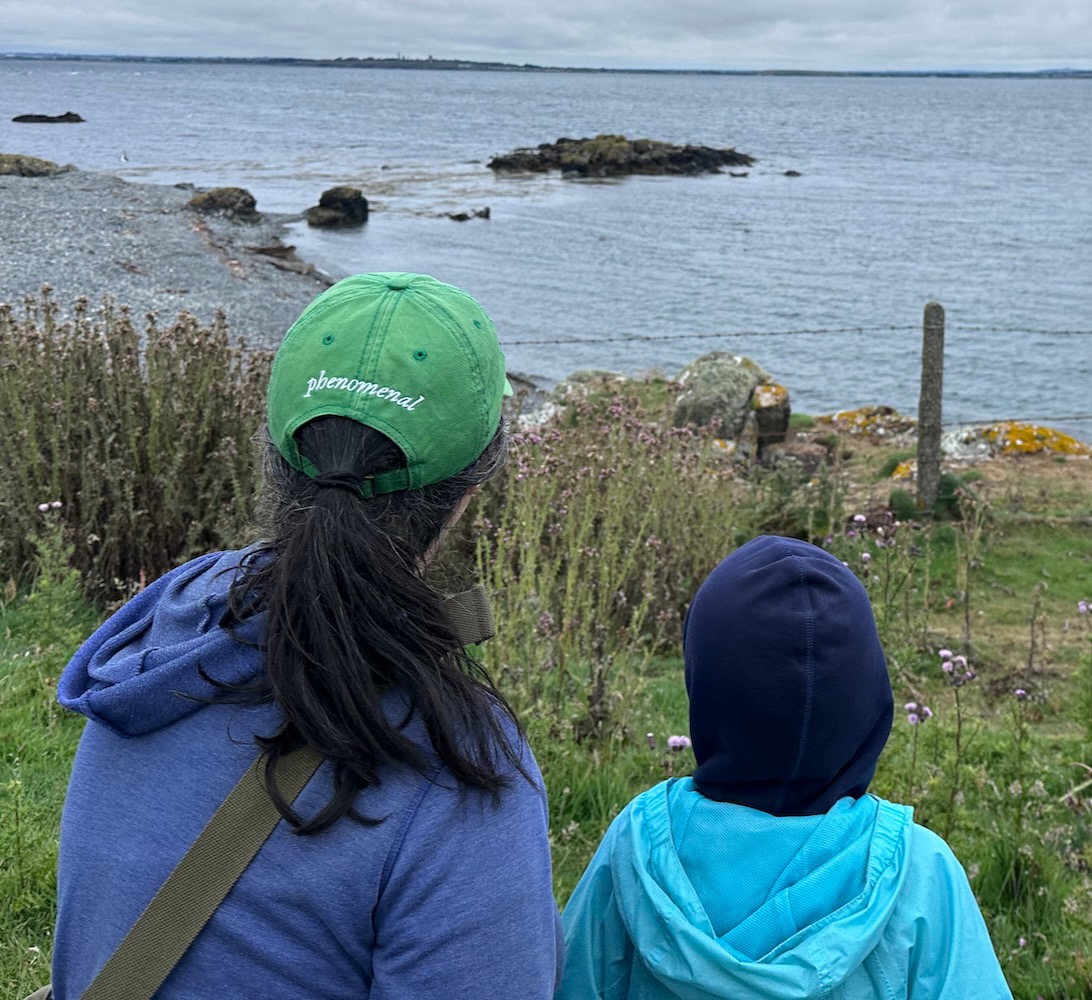
Samantha did not like the walk, which was basically walking through almost knee-high wet grass that contained a LOT of sheep poop, a whole lot of wallaby poop (much larger than the sheep…), and also half a dozen or so bloodied bunny bodies scattered in for good measure (the vultures go after them). Before we went up to the cairn, I walked Samantha back to the stone wall with the columns and the little porch roof over it, and she hung out there with her kindle while I rejoined them all and walked to the top. Even more animal poop and wet grass and bloody bunnies! Our socks were completely saturated, and I’m SURE we stepped in things, because there was virtually no way to avoid it. But it was so much better than the horses, for me—one foot in front of the other, just keep walking, and very beautiful all around. Plus the locals were talking with us, which was fun. (Generally not the 40-something couple, who were cool and fit and seemed to wonder why they were saddled with this group of misfits—Marcus and Robert helped one of the grandpas up and down the steepest sections of the climb, and one of the grandmas kept stopping and not quite going to the top of things, or the edge of the cliff. I contemplated joining her, but persevered. Another grandma kept giving little shrieks of “jaysus save her!” and hiding her head on my shoulder at Helen bounding and romping up and down the hilly parts like a little mountain goat, all sure-footed and light and not even close to falling.
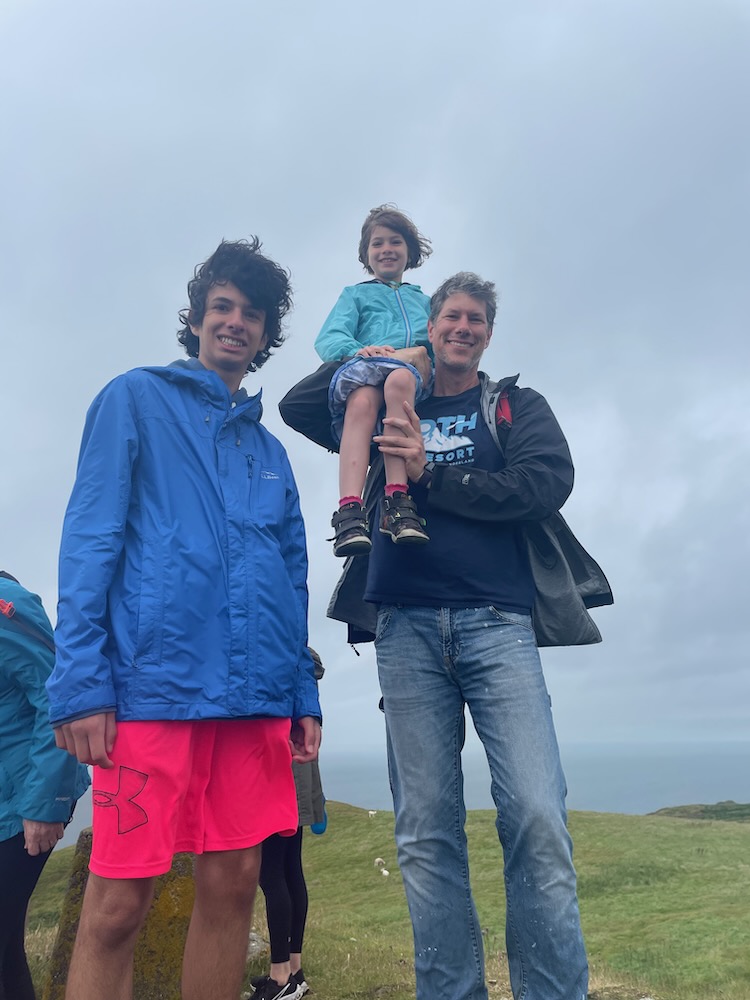

We didn’t make it to quite the furthest point on the island, where you could see the rocks that were responsible for a famous 19th century shipwreck—also a White Star ship of a new design (this one a three-masted sailing ship with an unusual distance between the masts that wasn’t able to keep its balance in the high winds) from Liverpool, on its maiden voyage (this one going to Australia for their gold rush), known (later) as the Victorian titanic. Eamon said he shortened the walk because “you can’t do that in THOSE” nodding at my Crocs, but I think none of the grandmas and grandpas minded, and the walk was lovely as it was.

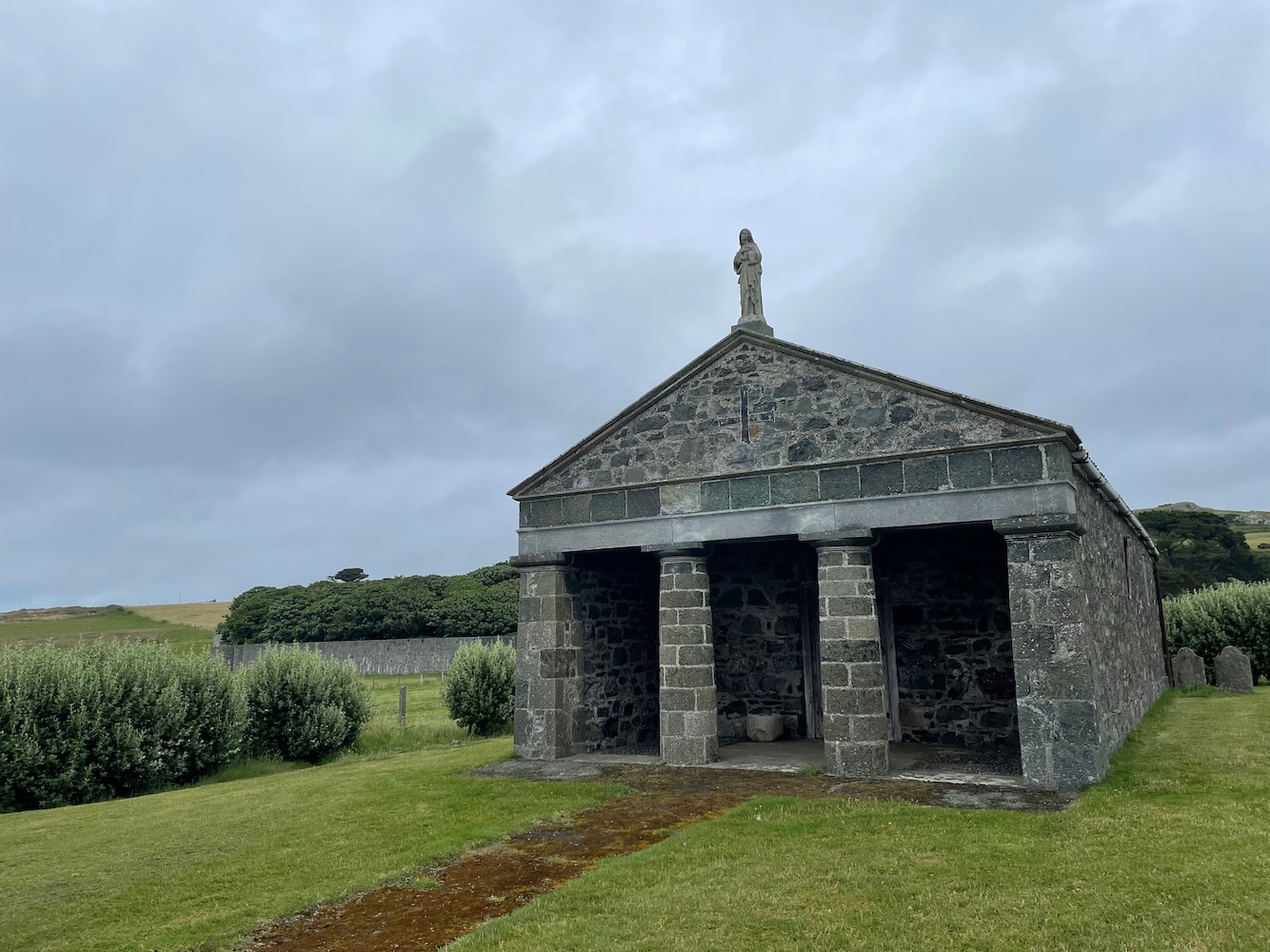
When we walked back down to the harbor he set up a bbq on the stone jetty and suggested we all go “sea swim.” Only the 40-something couple took him up on that, immediately changing into bathing suits (“togs”) and going on, swimming vigorously for about 20 minutes or so Marcus tried to get Robert to play frisbee with him for awhile.
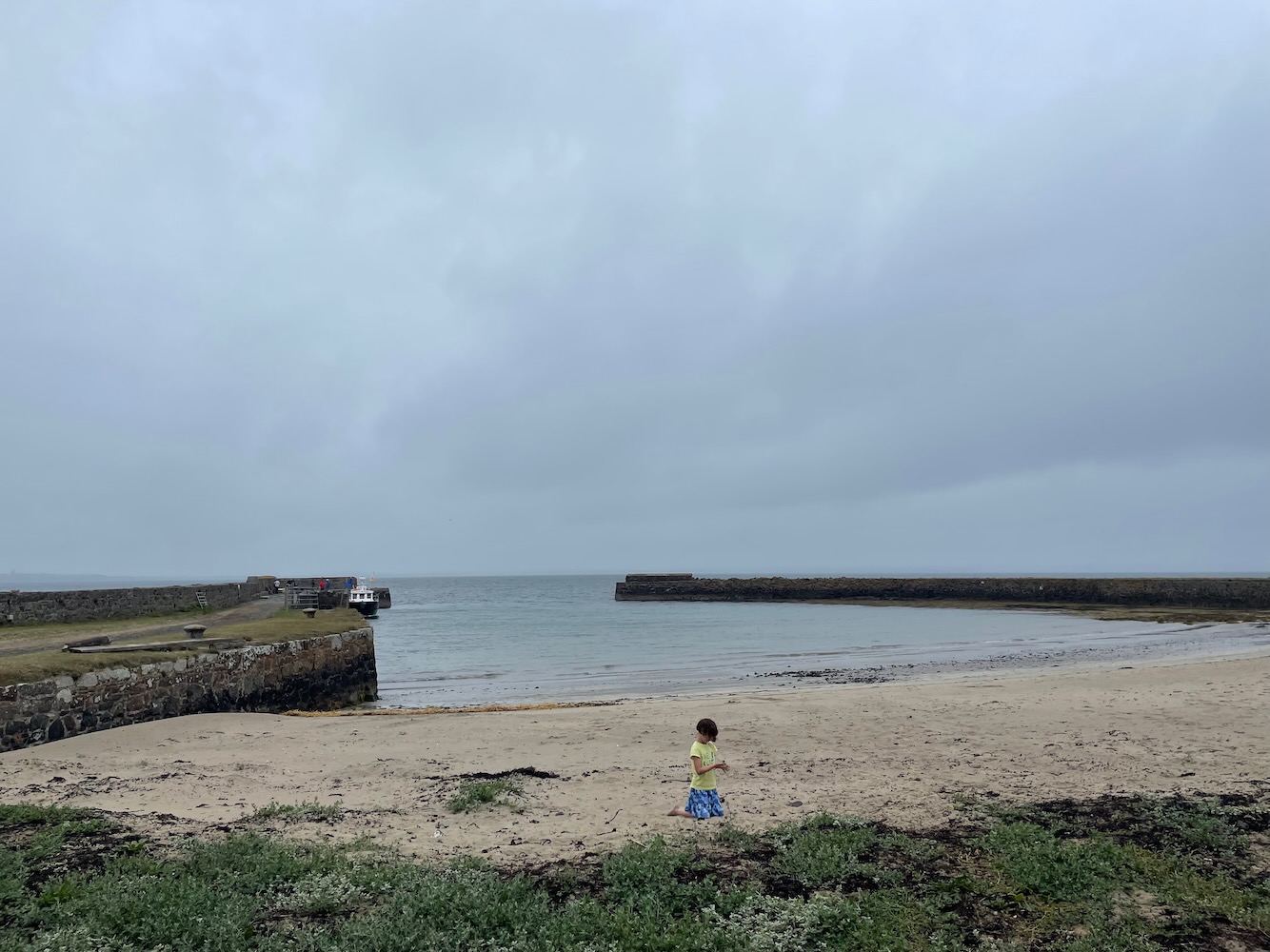
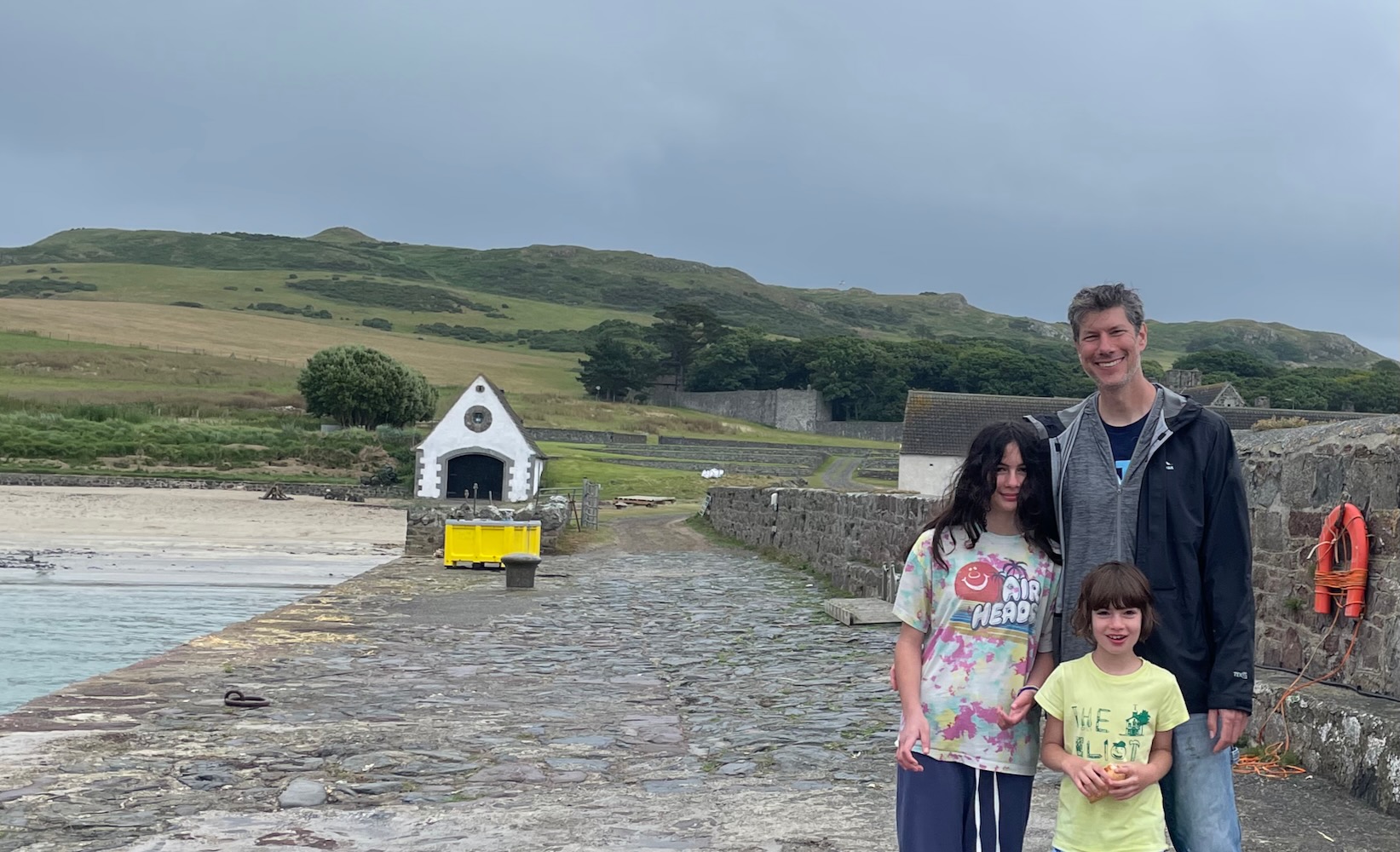
Robert was tired, though, and seemed to prefer to sit with me and a grandma or two, so he suggested Samantha go, and she did, and they threw a frisbee around happily for awhile. N.b. when these sibling moments of companionable frisbee master classes arrive, we just stay totally silent, trying to pretend we don't exist. Don't disturb them!
Helen had become something of a mascot for our trip, and the grandmas all loved how she would gallop back from the beach with a skirt full of shells for me to save, then run back again, sandy and happy.
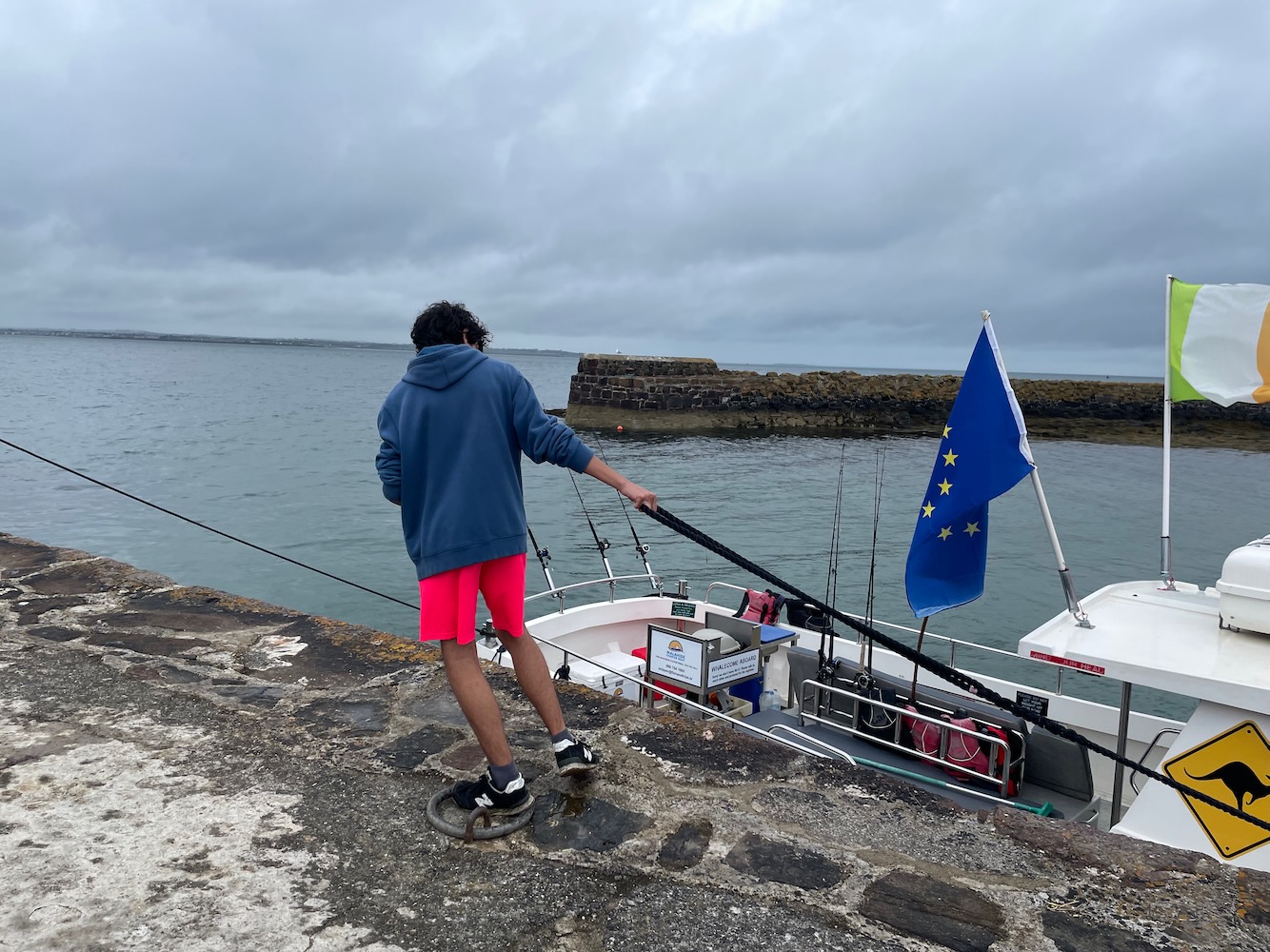

Then the bbq was terrific—Eamon had grilled sausages for breakfast on board the boat as we were heading out in the morning, folding them up in a soft piece of wheat bread for people to eat, and that had been a nice supplement to our hotel cocoa (we bought an Aero cocoa mix that really is exceptionally good, and used the hot water maker for tea for it) and supermarket pancakes, but now he grilled fillets of salmon, chicken thighs in a piri piri marinade, as well as more sausages, burgers, and pepperoni slices, and there were rolls and pickles and lots of condiments. Samantha had two sausages for each meal, and Helen ate two big salmon sandwiches now. Marcus had a couple chickens and a burger, and Robert had a salmon and a burger and now engaged all the Irish people from our boat in a conversation about burgers. Weirdly, his questions to them resembled those of the little girls to the tour guide in the chocolate factory: “do you ever make rare burgers?” No, never. “Really? You’ve never had a rare burger?” Really. Never. “Do you know anyone who has?” No one eats rare burgers. It’s not safe. And so on.
But it was just a glorious day standing out on the pier and eating and talking, all hungry and happy. One grandma brought a tin of slices of chocolate biscuit cake that her 70 year old neighbor made, and shared it around (very like a lolly cake/lolly slice from New Zealand) and “the priest” brought out a couple punnets of strawberries and shared them around.
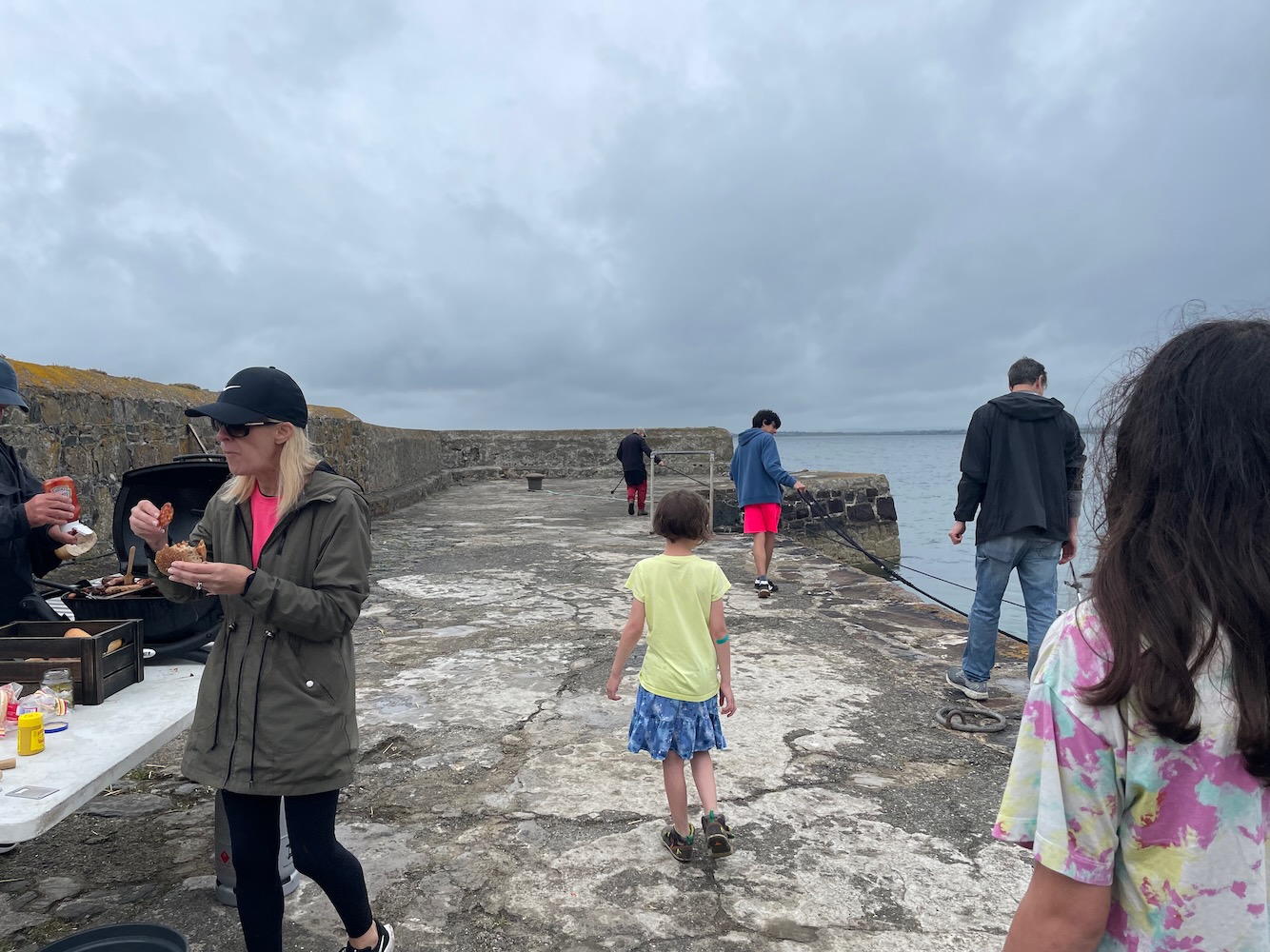
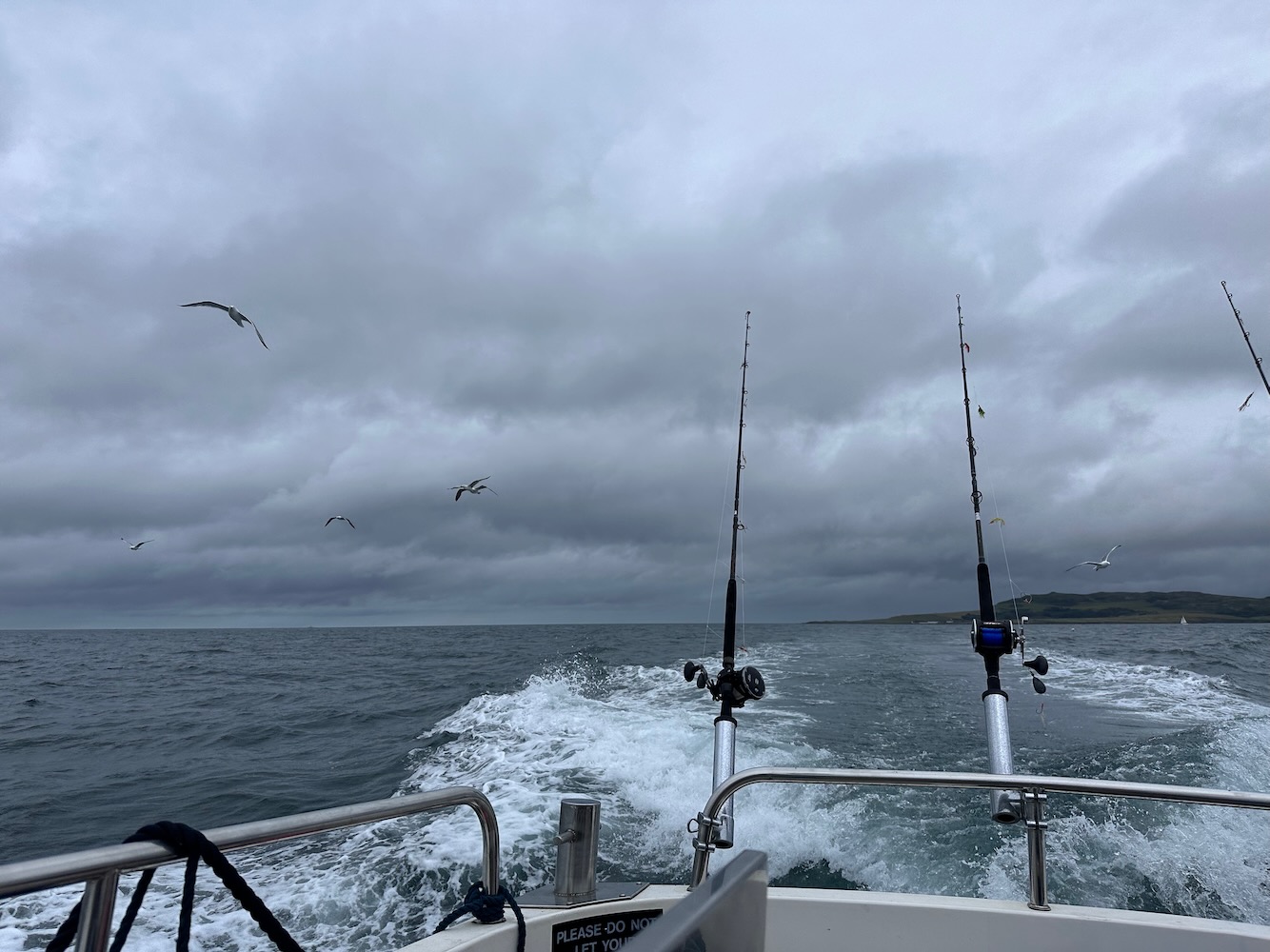
“Ah, she’s a great girl, a great girl,” one of the grandmas pronounced about Helen, and then made everyone pose for a group picture. Marcus helped tie a knot when Eamon moved the boat further down the dock to its lower-tide spot, and Robert was proud. We got back to town a little after 1:00, and I think everyone had had a lovely morning.
From the marina we went straight to a Tesco (first marveling at the set of washing machines and dryers in a corner of the parking lot—what a great idea! Put in some clothes to dry while you shop!) and got more pancakes, some supermarket brand freshly made donuts (a pack of 6 sugared custard-filled was 1.50 euros), more clementines (liking the .59 cent per bag price), some smoked salmon, a big round loaf of bread, some cheeses, and some Cadbury things and more nestle Aero to bring back for Sarah. Sidenote: we also spent a long time in the tea aisle discussed Irish tea. Robert had read that Barry's and Lyon's were the best, and that there was a rivalry between them, but when we got home I made everyone do a blind taste test of teabags we'd taken from the hotel rooms--Barry's, Lyon's, and Bewley's--and Bewley's won by a landslide.
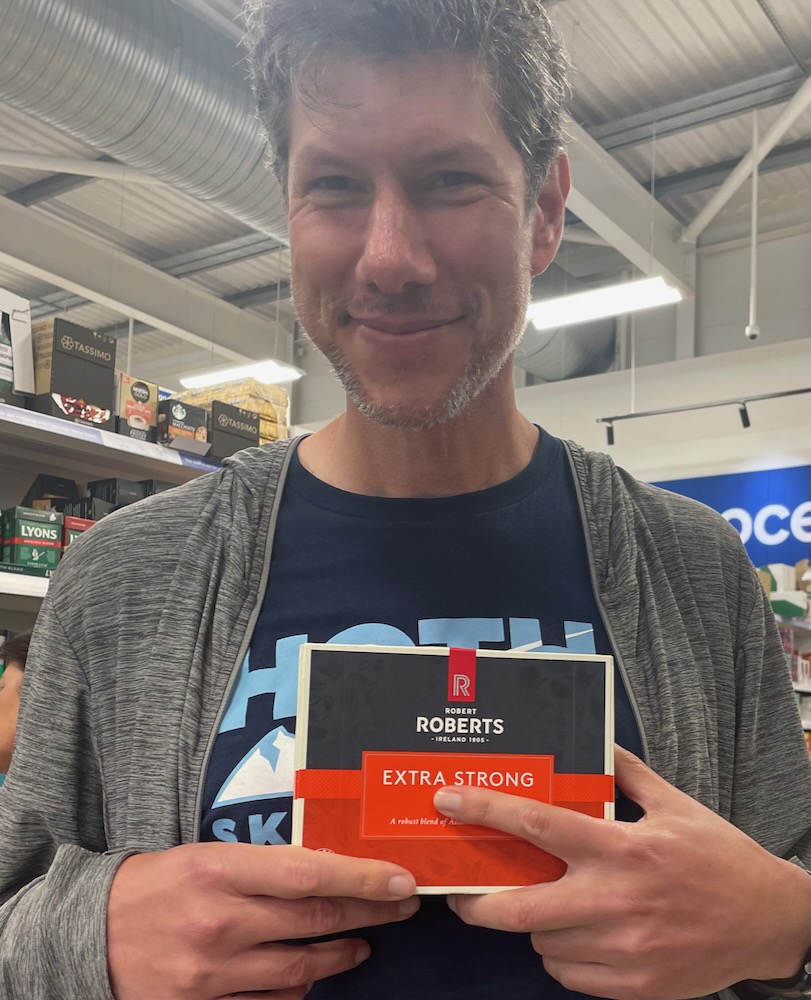
Then we drove up to Skerries (with a quick stop at our hotel to pick up dry socks for Marcus and Helen) to go to the Skerries Mills. We fell into their 3:30 guided tour, which ended up being just us. The mill site has been continuously used as a mill from the 11th century through the 1980s, which is pretty impressive. There’s an old water mill, as well as two windmills, one from the 1400s and one a couple hundred years newer. The guy giving the tour, whose family had owned the brewery at the next site over for four generations, was very happy to talk us through their somewhat random collection of old farm equipment (“people have it in their attic or barn and then they are cleaning out and give it to us, so we put it on display,” he shrugged) as well as opening the sluice gate and turning on the mill for us. First there were some handmills you could try, fitting a wooden peg into a hole and hauling the top stone around over the bottom one with a little bit of grain between them, and then you saw the water mill at work, and also the pulley system they used for bringing grain up four floors in the mill house.
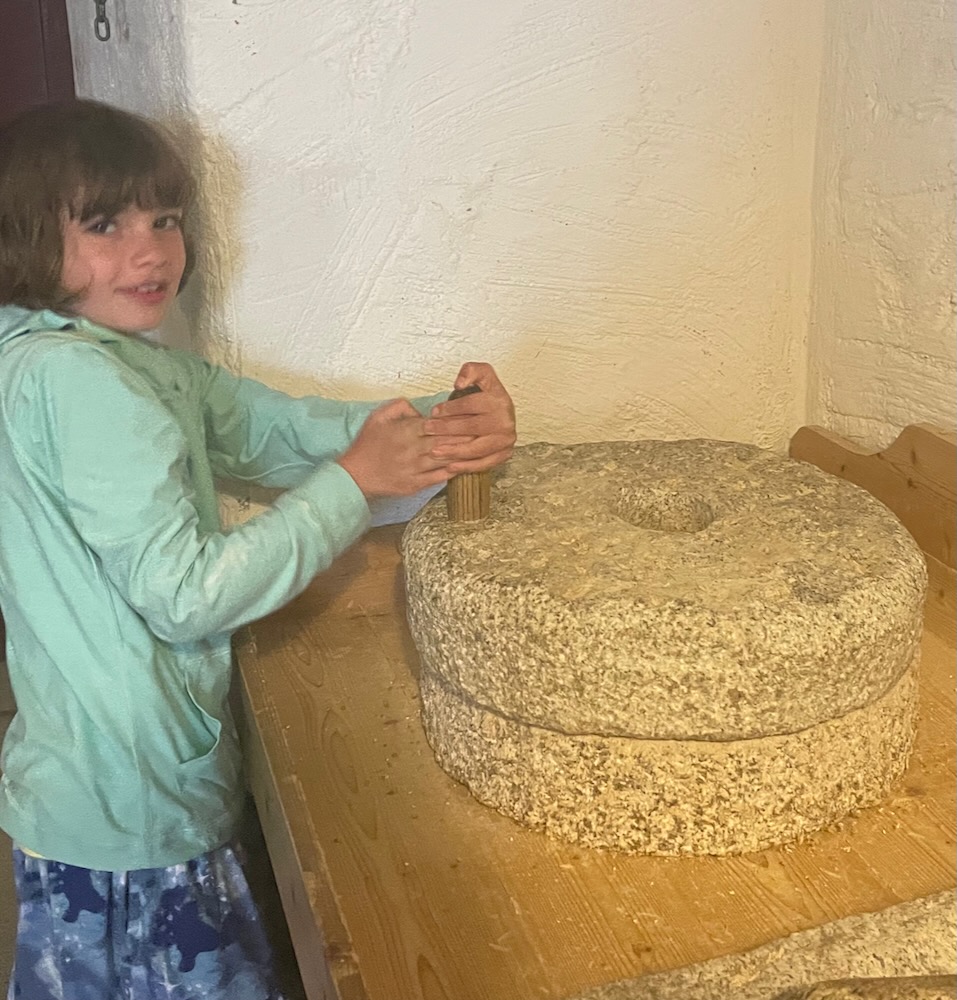
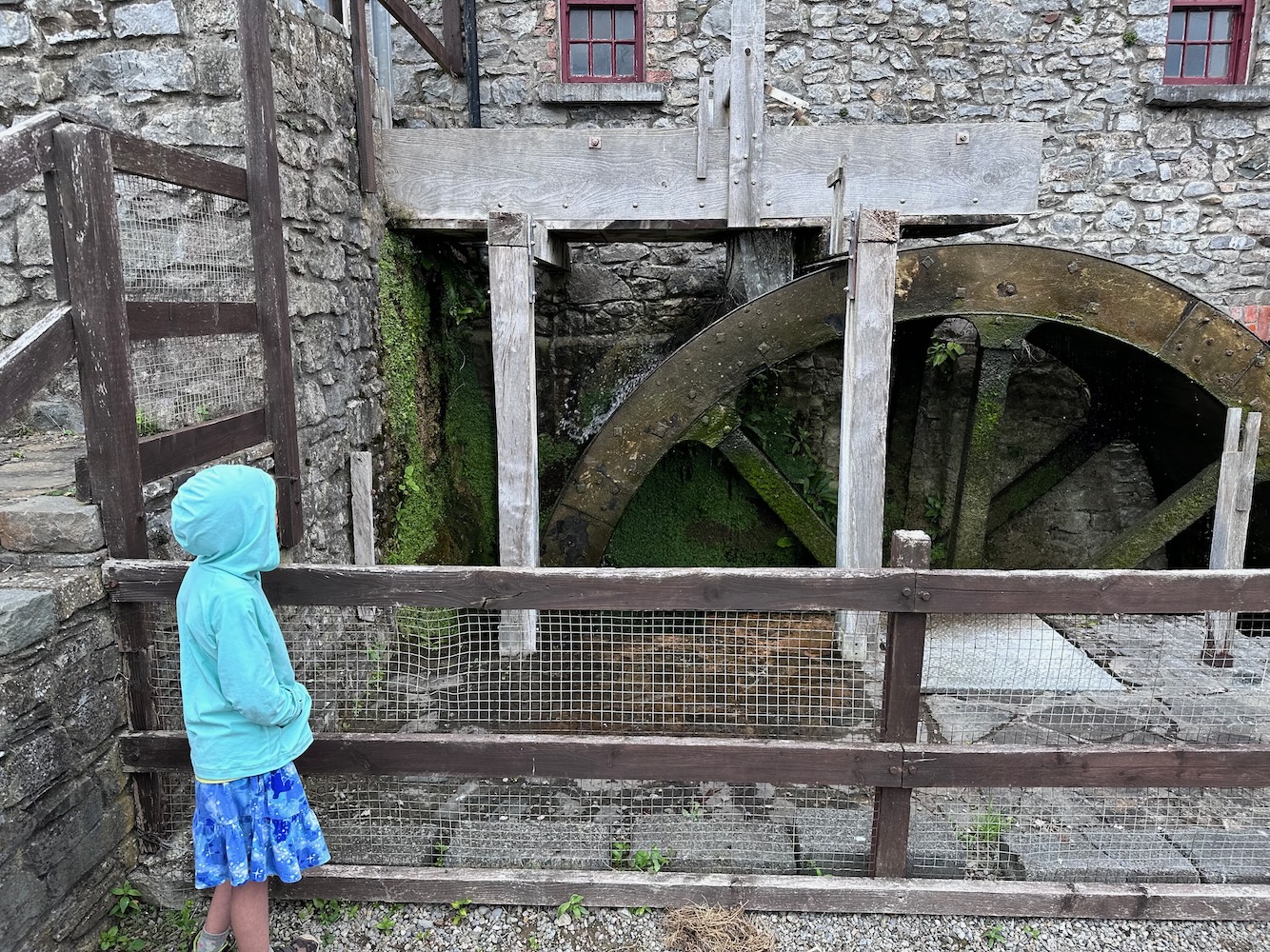
Then we walked up to the newer windmill and looked at that, and then over past a field of wheat (he said that specific field had been planted forever, as long as they were milling on this site, and they still plant it every spring and harvest it every fall for demonstrations, even though they don’t mill here anymore) to the older windmill. There we got to climb up a couple floors to see the mechanism for rotating the sails, which is all original, all wood with a chain to lock it in place, and then below to see where the grain comes down from the millstone right into bags. We learned about the different groove patterns that the millstone carver used to use, and it was very cool.
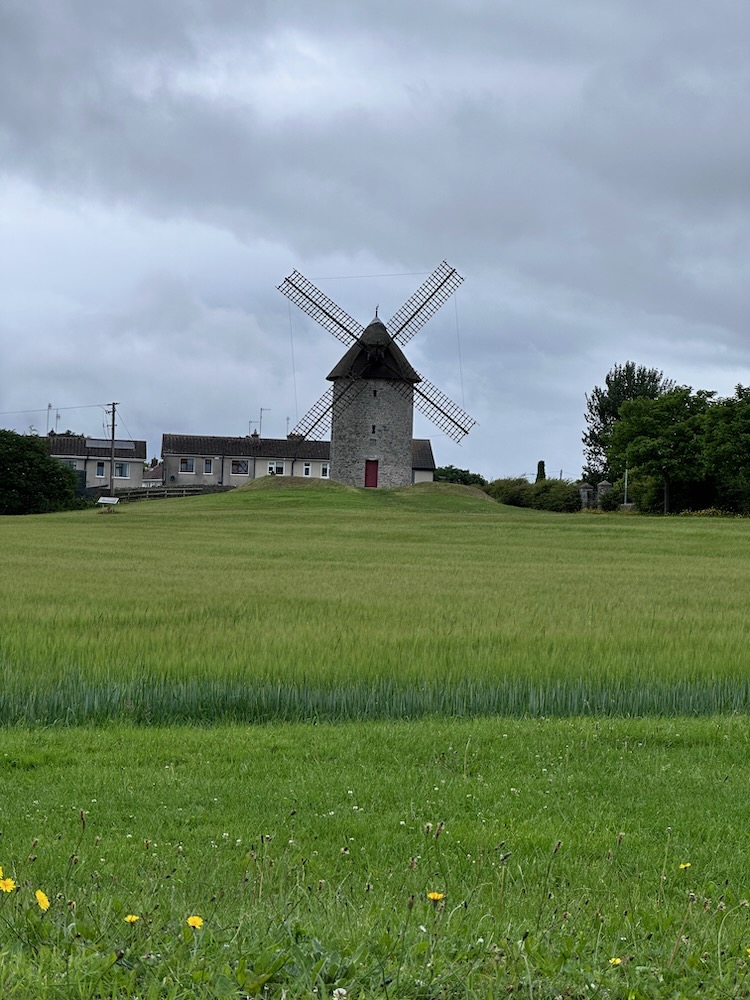
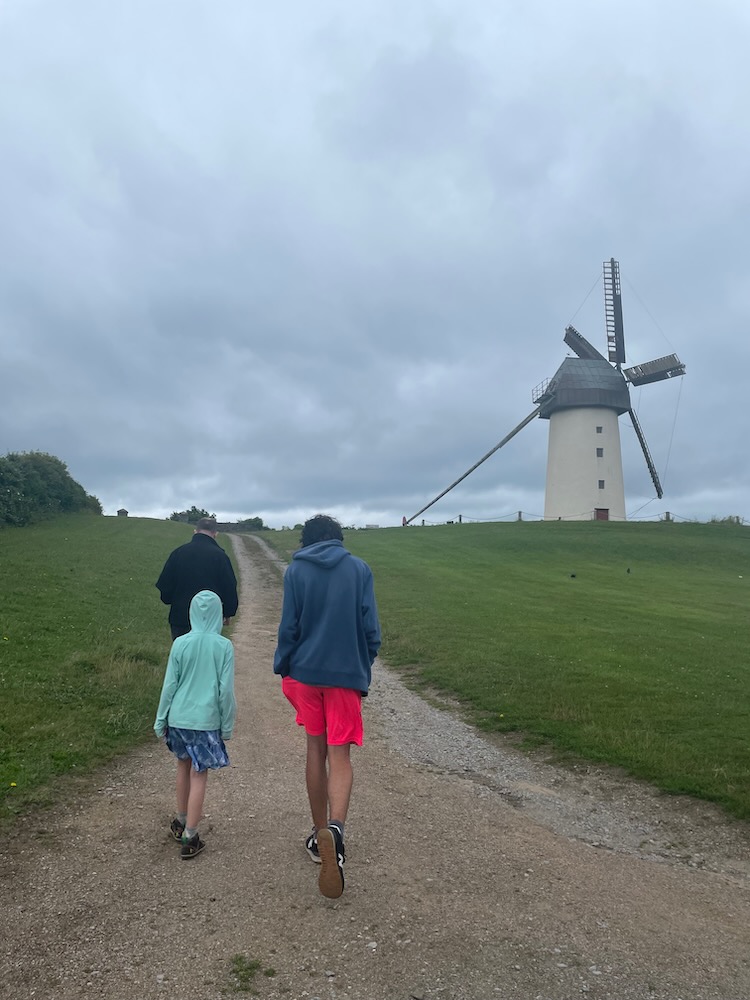
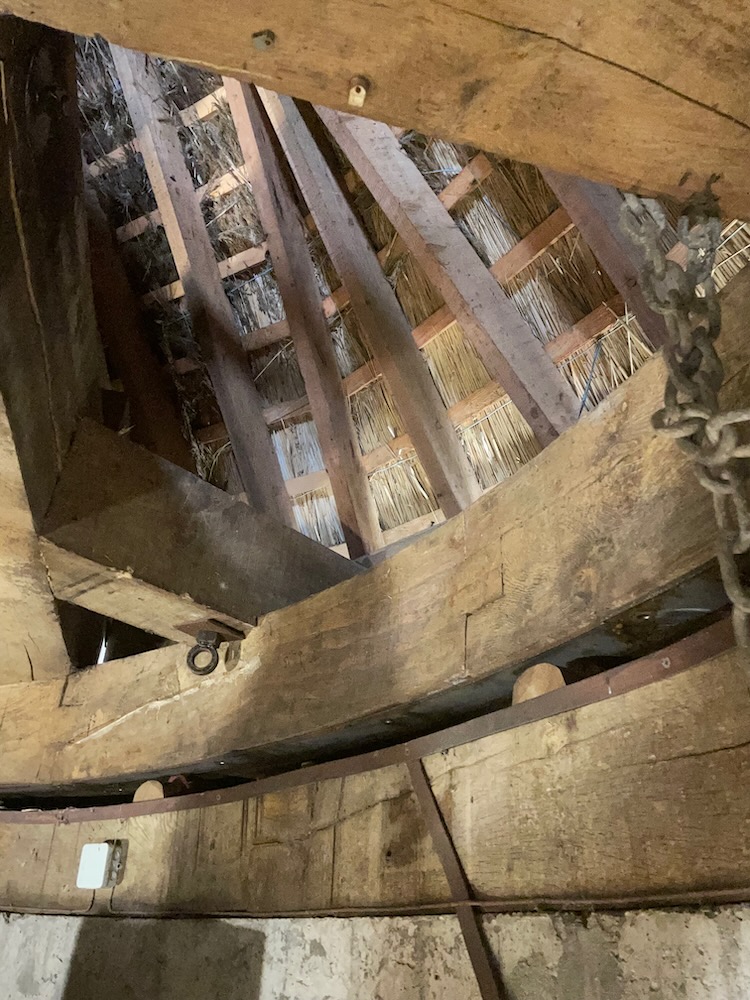
Helen was loving picking wildflowers from the fields before the mill, so she spent some of the tour fussing with a bouquet of flowers, and Samantha mostly read her book, but Marcus was fascinated by the tour.
Robert and I realized that we’d been to water mills, light houses, castles, and all sorts of other things, but we’ve never been to (much less inside) a windmill at all—much less one from the 1400s. Next to the mills was a nice playground with another long zip line, and the kids played (and squabbled) on that for a bit before we went to dinner.
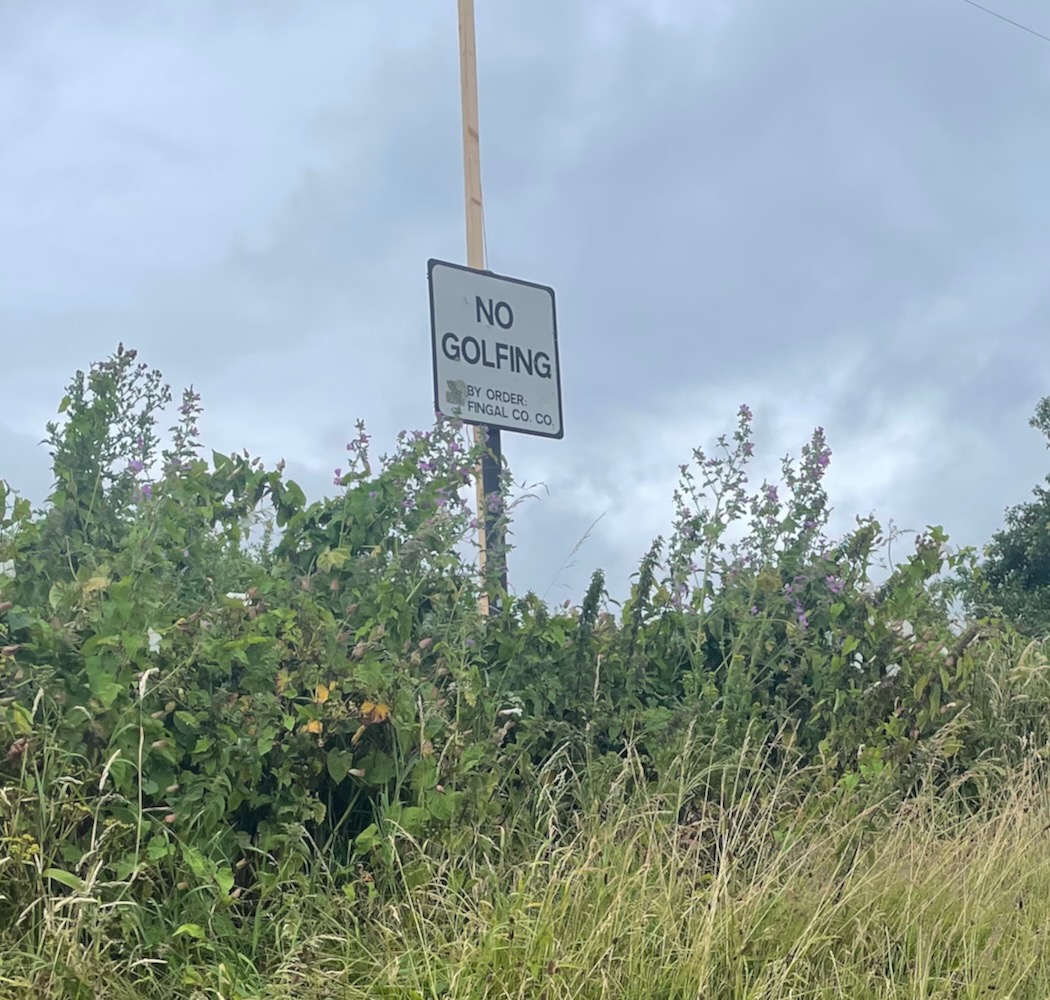

The first place we tried was full, even though it was only 5:00 (I guess Fridays are busier?), so we drove through some harbor areas and ended up at The Betsy in Swords, an over-the-top decorated place with fake flowers and trees and fairy lights and pink and cushions everywhere.
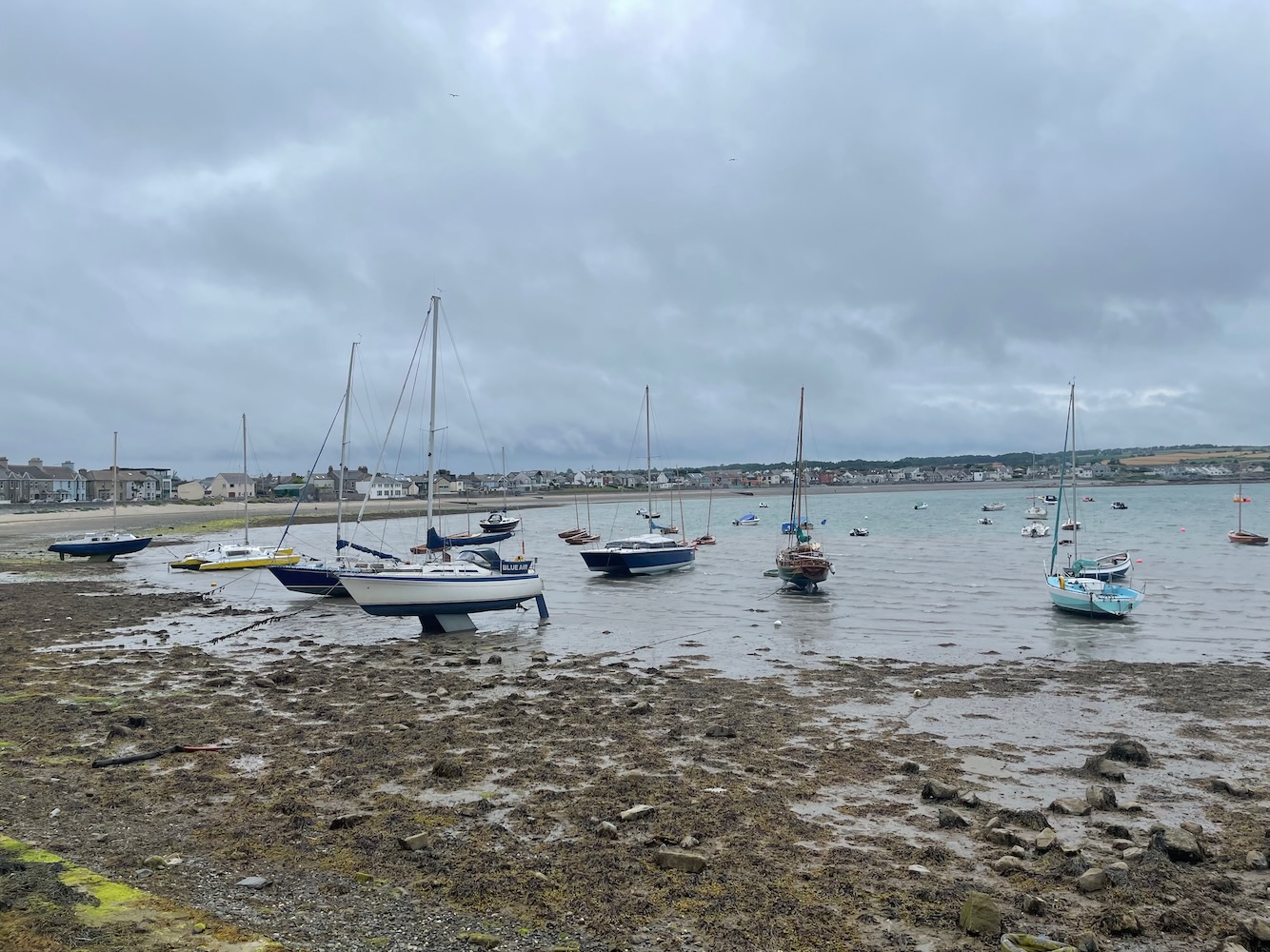
The restaurant was pretty wild. The food wasn’t the best, but their kids’ menu was very cheap, and Samantha happily ate their kids’ plain pasta. We had our final sticky toffee puddings of the trip here (no dates in this one), plus a bread and butter pudding and an Elton mess. From there we stopped for our final spice bag of the trip at Lin Kee just down the road. This one was very good (apparently it won a prize a few years ago), and the chicken was shredded/chopped up pieces of bigger fried chicken breasts, rather than individual popcorn-sized chicken pieces. We went back to the hotel and nibbled on it, while drinking some of the last of the Club lemon soda (“with real bits!” the bottle promised). It was a lovely final evening.
In the morning we got up and I made tea, instant coffee, and more Aero hot chocolate in the room, with clementines and supermarket pancakes, and we headed out to the airport. The rental car return went smoothly (we love Avis, from now on), and the Play check-in desk in the Dublin terminal was marginally less painful than in Logan.
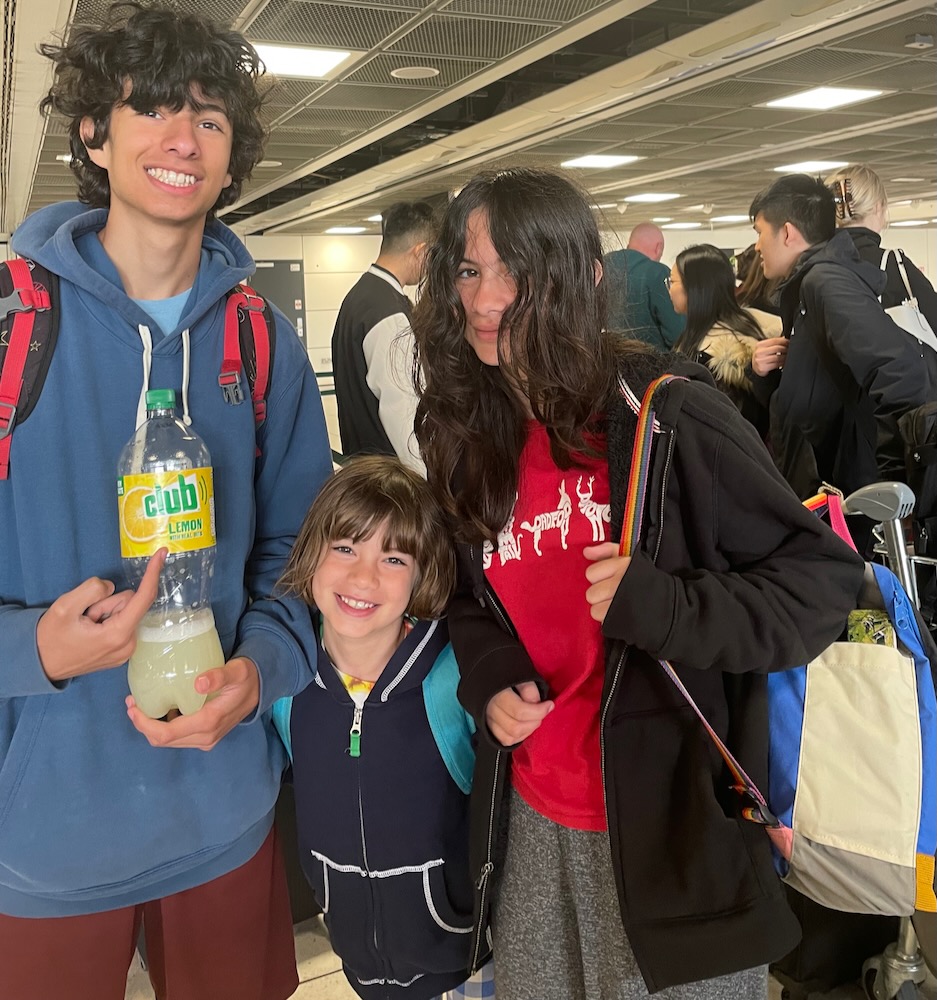
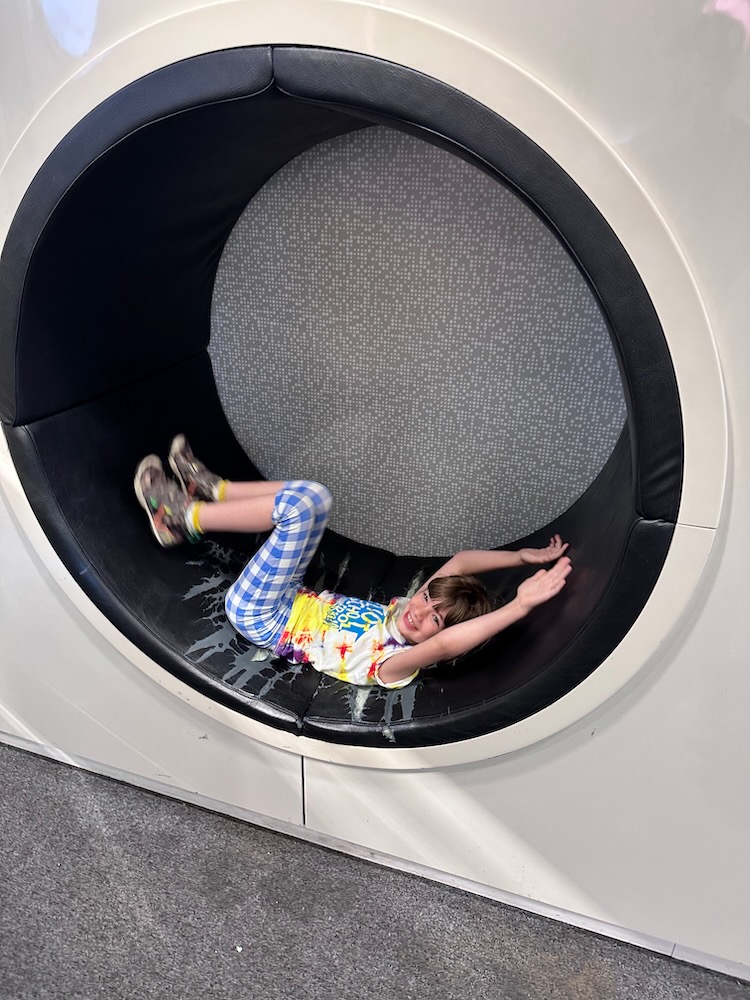

After grabbing breakfast burritos Irish-style (bacon and Irish sausages plus eggs, and I had breakfast beans in mine instead of salsa), we had a short and easy flight to Iceland, where we got the kids pizza and a ham and cheese stromboli and filled up water bottles and enjoyed their gleaming bathrooms. All the planes board/deplane outside, and in Iceland you have to take a shuttle to the terminal, so we were discussing the quite literal rocks in our bags when a couple other people on the shuttle joined in the conversation. Helen ended up trading an Irish rock for a Scottish rock with two college students who were charmed by her, and we had another smooth and easy flight. From start to end, then, our trip was wonderful, packed with varied, interesting activities, fun foods, and some great family time. Thank you, Ireland!
Below, Helen's journal for the trip:
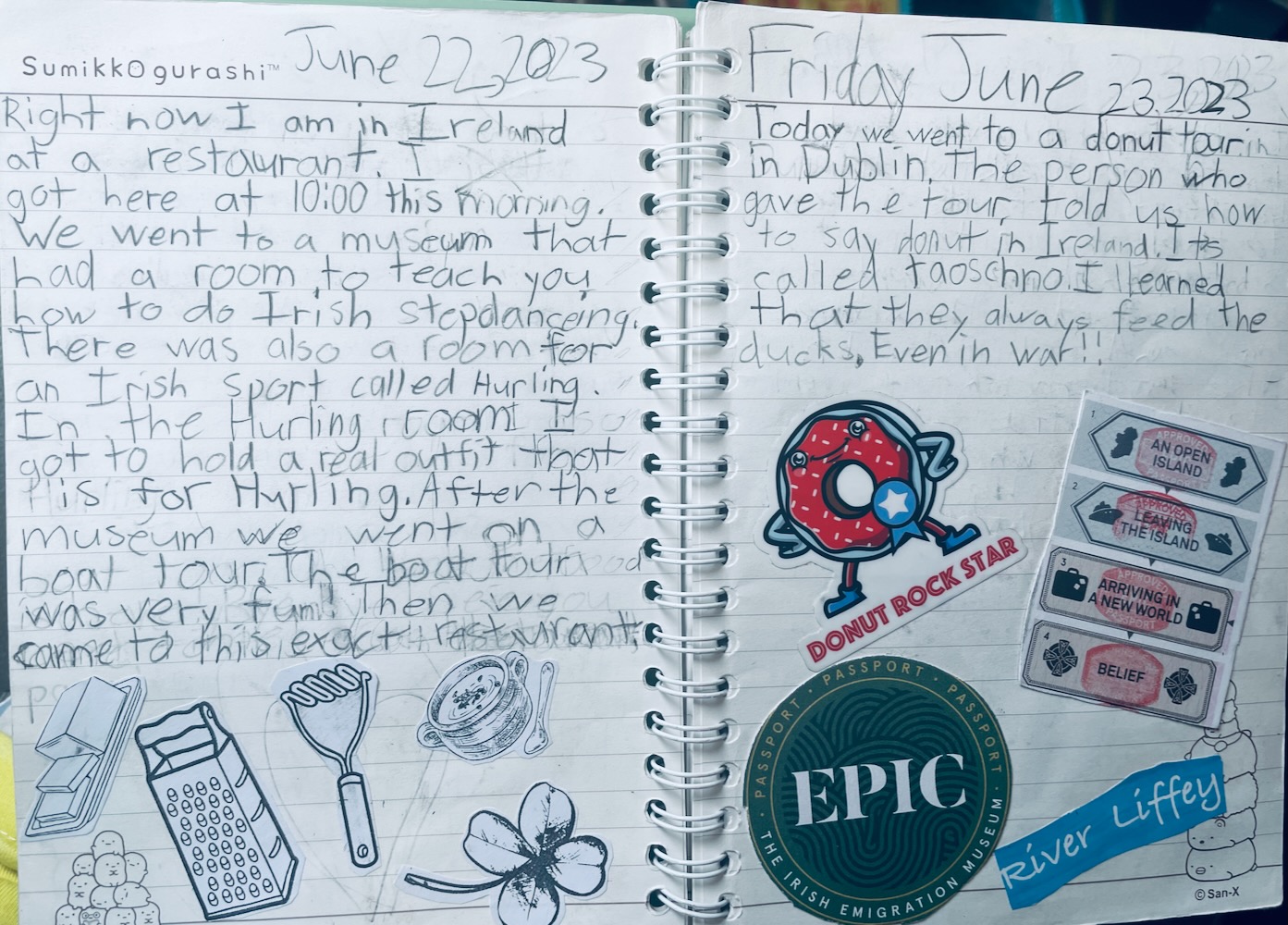
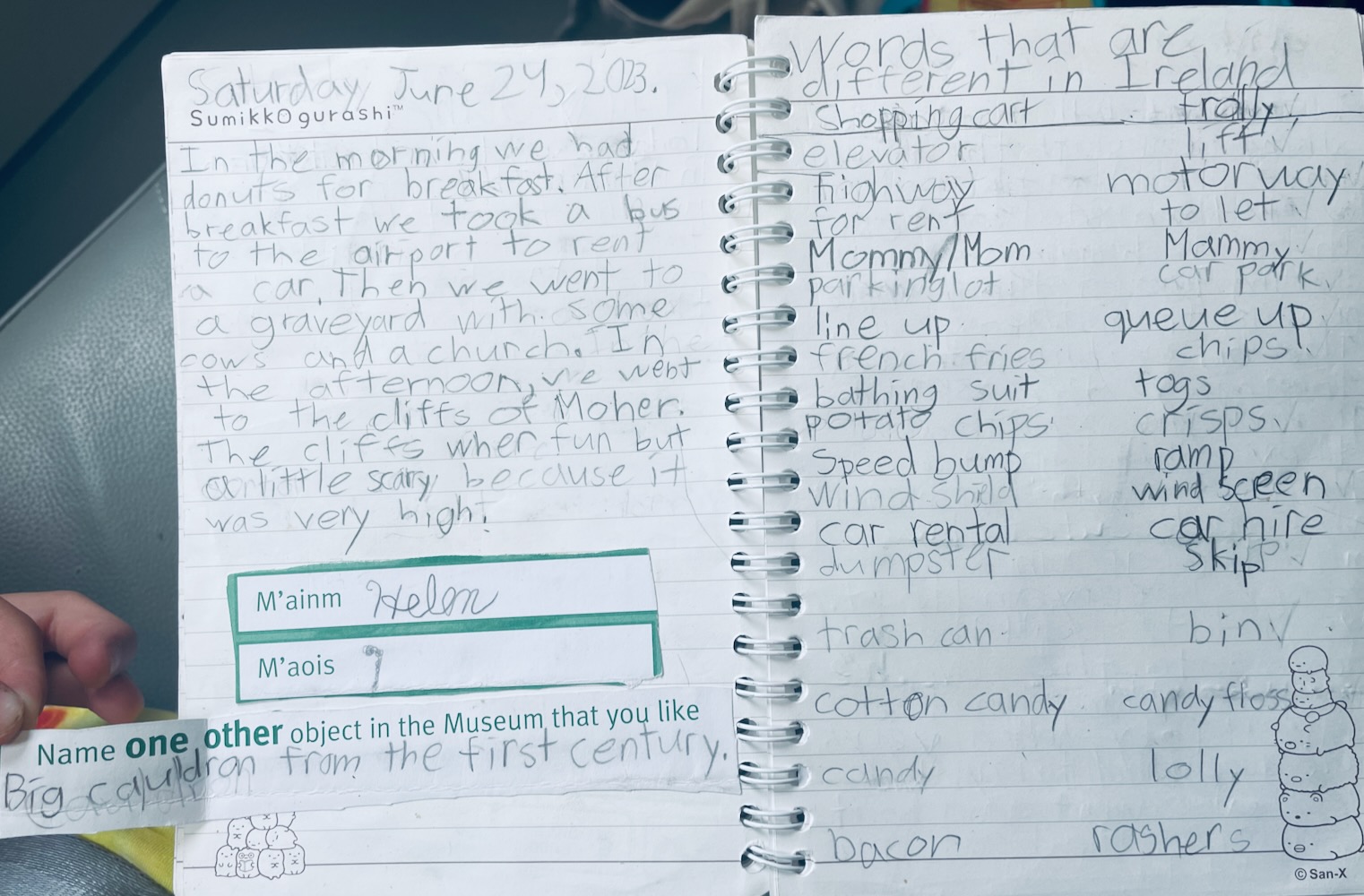
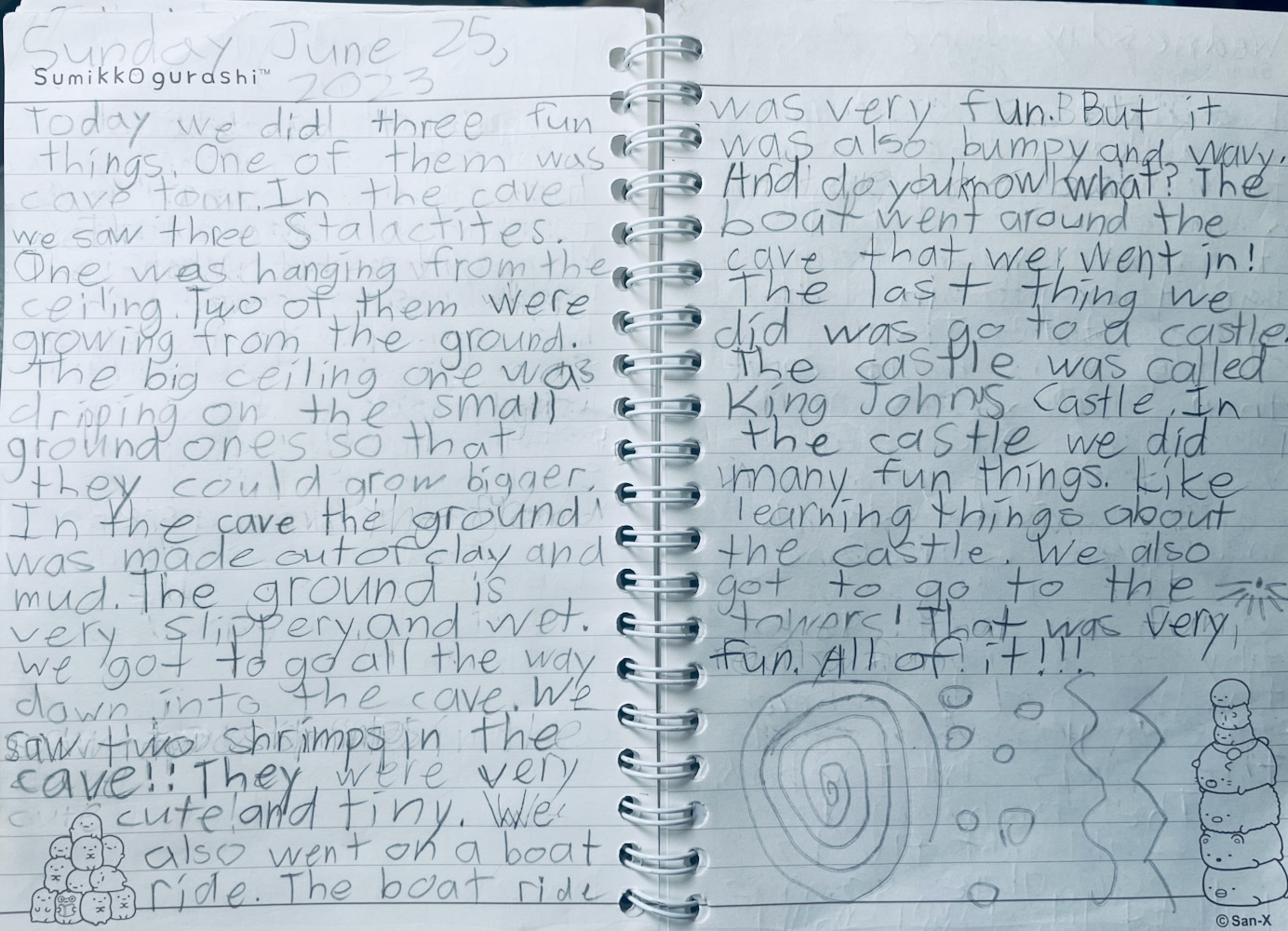
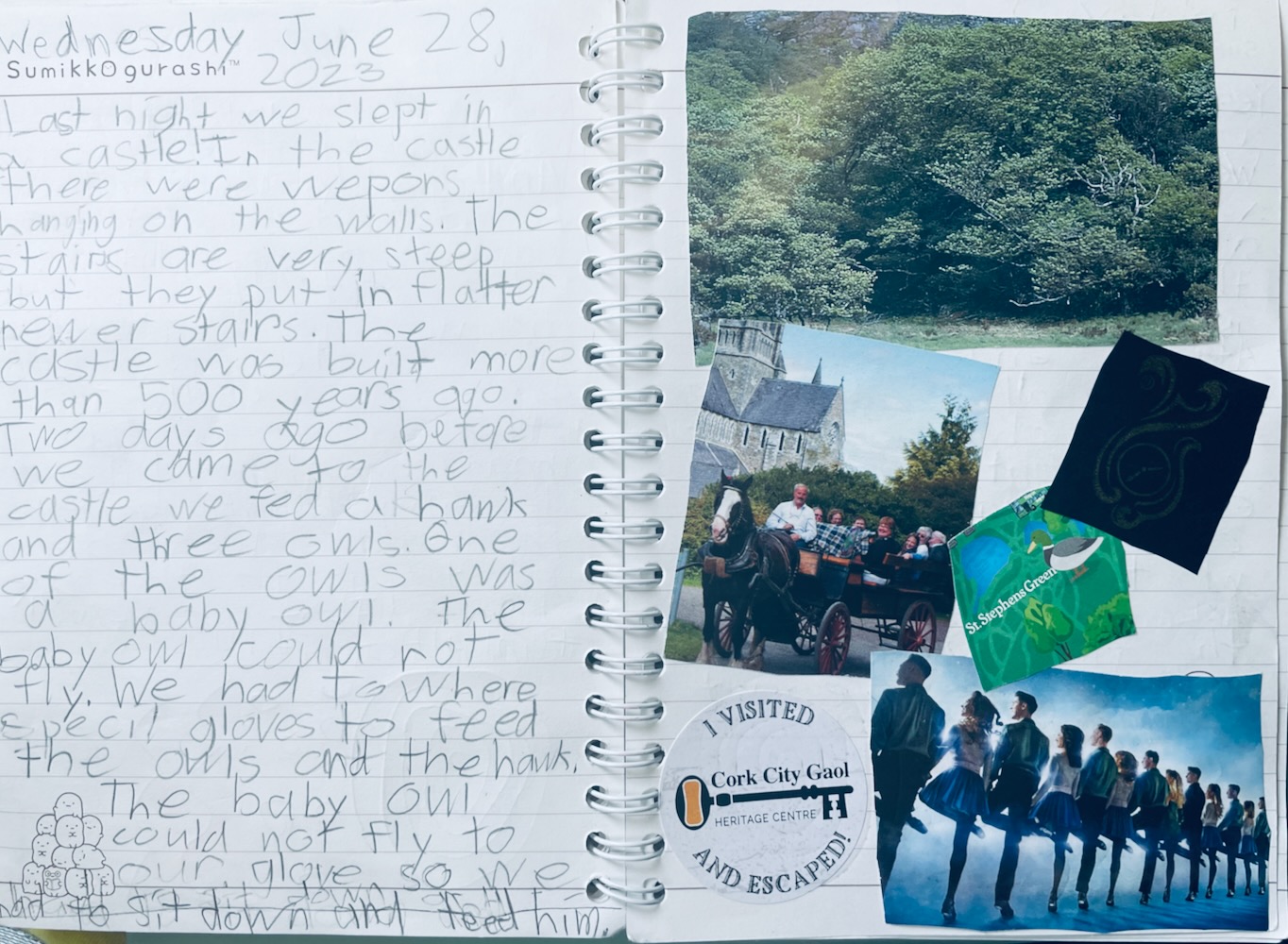
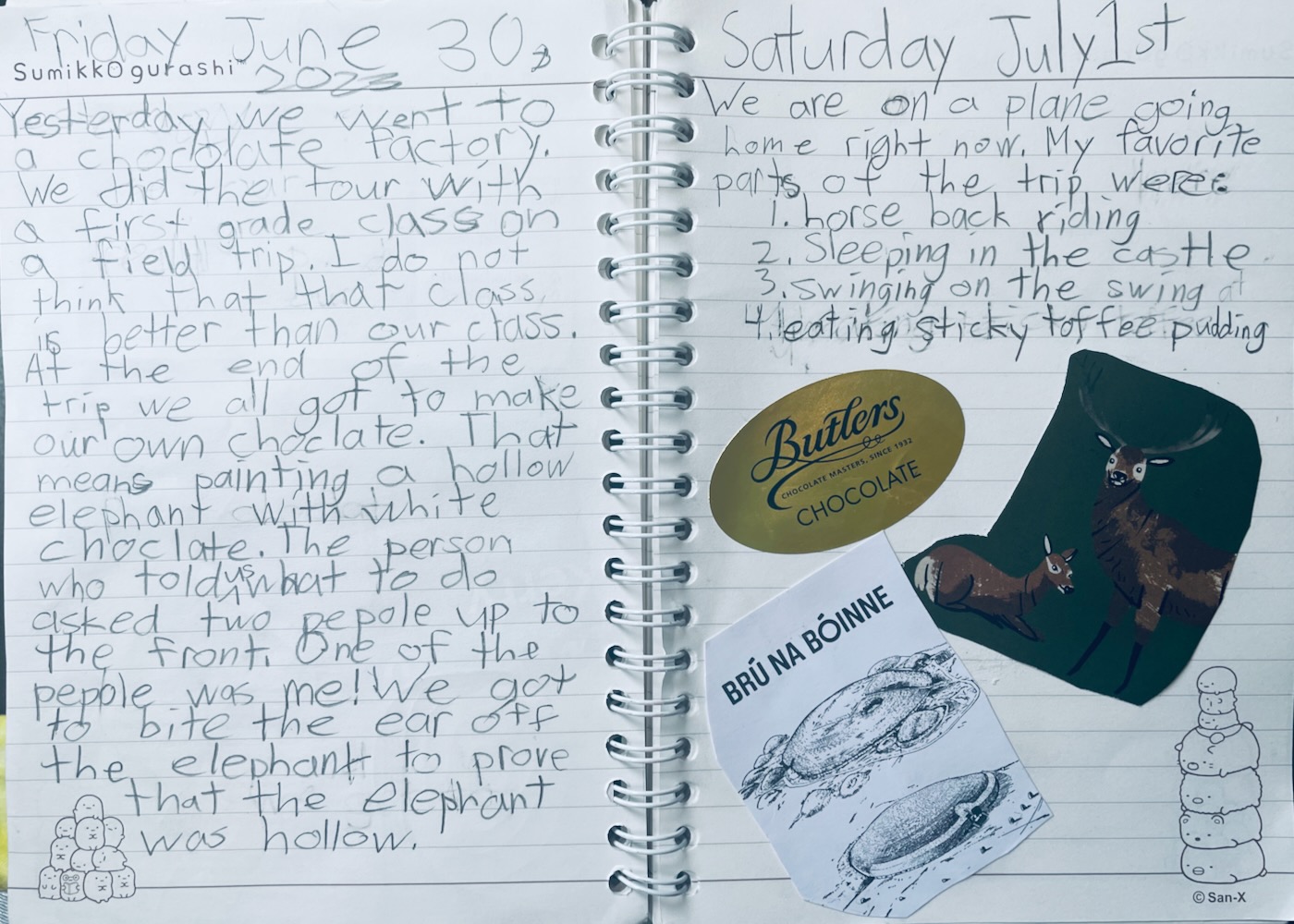
And a page from Samantha's sketchbook/scrapbook for the trip:
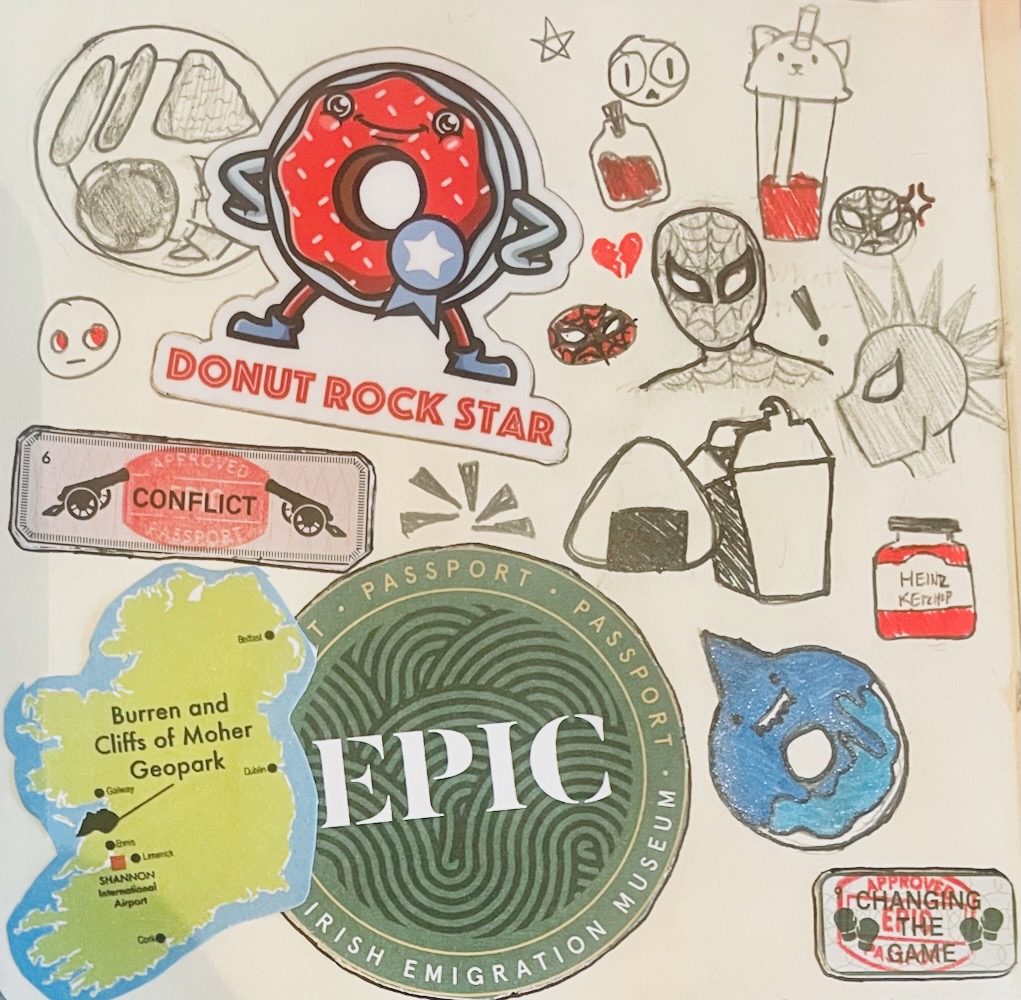
Go back to web essays.
robertandchristina.com
was made with a Mac.
© 2023 C&R Enterprises
Email christina@robertandchristina.com
or robert@robertandchristina.com
Created: 7/2/23. Last Modified: 7/2/23.